Prunus serrulata



Smooth
Bark that has a smooth texture and may be covered in lenticels.
Vase-shape
When a plant has upright spreading branches with an outline shape of a vase.This deciduous tree has a short trunk with many spreading branches that form vase-shaped crown. It has dark green oval leaves that turn yellow-scarlet during autumn and the drooping greenish-white to rose pink flowers appear in a cluster during spring.
Prunus serrulata is naturally found in Japan from Hokkaido to Honshu growing in woodlands on the mountains and in the adjoining valleys. It prefers a well drained organic rich moist sandy to clay loam that is tending acidic with a pH range from 6.0 to 7.5 and grows in a wind protected sunny position and is frost tolerant but drought tender.
The Japanese Flowering Cherry is grown for its flowers and rounded crown with autumn colour. It is planted in small or Japanese gardens as a specimen for summer shade or used in group plantings along pathways or avenues. It establishes in 5 to 8 years and is moderately long lived. It is suitable for low-mountain or inland regions, tolerating cooler conditions. There are many cultivars with varying flower colour available. Once established it has a high water requirement (Scale: 3-drops from 3), responding to mulch and an occasional deep watering during dry periods, particularly for young plants. ID 49
UK hardiness zone H6
Climate zones 3 - 7,14 - 20
USDA Zone 5-9
Prunus (PROO-nus) serrulata (SE-ru-lata)
'Prunus': Latin name for the plum; 'serrulata': with a serrated margin (refers to the leaves).
Prunus serrulata var. lannesiana
This tree varies from the species by having long pointed teeth along the margins of the leaves and produces pale pink fragrant flowers that are purplish-red at the base. Photographs in the gallery were taken at Tokyo Botanic Gardens.
var. lannesiana 'Azuma-nishiki'
This small tree has a short reddish brown trunk with long spreading branches that form an open rounded crown. During spring the deep pink buds open to fully double pale pink flowers that form dense clusters along the branches before the foliage.
var. lannesiana 'Chrysanthemoides'
This large shrub to small tree grows to 4 m (12 ft) tall with a short greyish trunk and spreading branches that form a rounded crown. During spring it produces clusters of tiny Carman red double flowers up to 10 mm (3/8 in) wide with the coppery coloured new growth.
var. lannesiana 'Kanzan' syn. 'Sekiyama'
This popular Japanese flowering cherry grows to 10 m (30 ft) with a stout coppery-red peeling trunk and spreading-pendant branches to ground level forming a domed canopy. During spring the new foliage has a bronze tinge becoming green and accompanied with pendant clusters of long stemmed deep pink double flowers up to 12 mm (½ in) wide. In autumn the leaves turn bronze-orange before falling and are vibrant colour contrast along borders.
var. speciosa
This small tree grows to 5 m (15 ft) tall and wide with a short dark brown trunk and widely spreading branches that form a dense crown. The new growth has a bronze tinge and matures to dark green. The saucer shaped single white flowers are suffused in pale pink from the centre and appear during early spring in large clusters amongst the new foliage.
Cultivars
'Amanogawa'
This shrub to small tree grows to 6 m (20 ft) with spreading branches forming a rounded crown. During spring it produces semi double, pale pink to white, fragrant flowers in clusters.
'Daikoku'
This upright spreading shrub to small tree can attain a height of 10 m (30 ft) with a coppery red, peeling trunk and is covered in dark green lanceolate leaves with an acuminate apex the turn yellow during autumn. It produces bowl shaped large fragrant double flowers with over 40 petals that are pink, tinged with pale pink, singularly or in groups up to four over the plant during spring. The flowers are followed by avoid reddish fruit that is up to 12 mm (½ in) long and the tree is commonly used in parks and gardens as a specimen or in group plantings.
'Fugenzo'
This small tree grows to 8 m (25 ft) with spreading branches forming a vase habit. During spring it produces large double pink flowers in clusters.
'Gioiko'
This unusual small tree grows to 8 m (25 ft) with spreading branches forming a vase habit. During early spring it produces clusters of creamy green saucer-shaped double flowers that are highlighted in pink from the base extending along the central veins. It is not commonly cultivated and may be difficult to obtain requiring a specialist nursery.
'Ichiyo' Japanese Flowering Cherry, Hisakura Cherry
This small tree grows to 6 m (20 ft) tall and wide with spreading branches with dark green foliage forming a rounded crown. During mid spring it produces clusters of reddish buds that open in semi double to double pale pink flowers with over 30 petals in each row appearing prolifically over the tree. It prefers an open sunny position and grows well in soil that is neutral tending alkaline. It can be planted in zones 5-9 and is suitable as a feature tree in a small or Japanese garden.
'Joh nioi'
This small tree grows to 6 m (20 ft) tall with a short trunk and spreading branches that form a rounded crown. The dark green serrated leaves are tinged bronze when young and during mid to late spring it produces pendant clusters of single white saucer-shaped flowers. It is planted parks and gardens as it showed tree or used as a specimen in small or Japanese gardens.
'Mikuruma-gaeshi'
This small deciduous tree is upright with ascending branches forming a small rounded crown up to 10 m (30 ft) tall. The bronze new growth becomes dark green, turning red and yellow during autumn and the delight Apple fragrant white flowers are pink in bud appearing in spring.
'Shimidsu Sakura'
This shrub has many branches and grows to 4 m (12 ft) tall forming a bushy habit. During spring it produces ruffled deep pink flowers in clusters.
'Shujaku'
This shrub to small tree grows to 5 m (15 ft) tall and wide with spreading branches that form a compact rounded crown with green foliage that is tinged copper. During late spring with new foliage it produces abundant very large double pale pink flowers on a long pedestal singularly and in clusters. It is an ideal specimen plant for a park or large garden and can be used in avenue planting. It is suitable for cool climates, and I have seen it growing happily in Tokyo and Edinburgh.
'Okumiyako'
This small tree has spreading branches that form an open rounded crown. It produces clusters or white flowers that are flushed pink during spring with the new foliage. It is planted in avenues in large gardens or used as a specimen in a Japanese garden.
'Shirotae' 'Mt Fuji'
This deciduous tree is upright with spreading to horizontal branches to 6 m (20 ft) tall and has reddish autumn foliage. The pink buds open to reveal fragrant double white pendant flowers that appear in clusters during spring and the plant may be grafted onto standards that are up to 2 m (6 ft) tall. This tree is planted in gardens as a specimen and is suitable for cool mountain regions.
'Shirofugen'
This tree is upright with spreading arching branches and produces pendant white flowers that are suffused in pink.
'Takasago'
This small tree grows to 5 m (16 ft) tall by 4 m (12 ft) wide with a greyish trunk and spreading branches that form a compact rounded crown. It has bronze-green new leaves and during spring the pink buds produces semi-double pale pink to darker pink saucer-shaped flowers in clusters that cover the tree, giving a stunning display. It is used in small Japanese gardens or in streetscapes and parks as a feature plant. The exact parents of this plant are undecided but the plant is commonly used in cool climate landscapes.
'Ukon'
This vigorous small tree grows to 5 m (16 ft) tall and wide with upright spreading branches forming a rounded crown. The new growth is a bronze green maturing to green and the finely serrated 110 mm (4 3/8 in) long ovate leaves turn orange-yellow during autumn. It produces pink tinged buds that open to semi double pink flowers that fade to white appearing in large clusters from mid to late spring. It is planted in small gardens along borders, giving an excellent floral display and autumn colour.
Rosaceae (ro-ZAY-see-ee)
Rose Family
Distribution
The plants in this family are found in many parts of the world with the greatest diversity in the temperate to sub-tropical regions of the northern hemisphere.
Diagnostic Features
This large family consists of herbaceous herbs, deciduous or evergreen shrubs or trees and some climbers. Some of the plants have branches with thorns.
The leaves are simple or compound (pinnate or palmate) and arranged alternately rarely opposite with or without stipules that adnate to the petiole.
The regularly normally bisexual flowers are arranged in a terminal or axillary racemose or cymose and paniculate inflorescence.
The commonly large and showy calyx has 4 - 5 sepals that are normally imbricate and often epicalyx with 5 extra sepal-like organs. The 4 - 5 petals are sometimes absent and are available in a wide range of colours except blue..
The whorled stamens number twice or more than the petals and are perigynous.
The ovary is superior or inferior with one to several carpels that are free or united.
The fruit is a capsule, pome, drupe or achene containing seeds that lack endosperm.
There are 85 - 100 genera with around 2,000 species or more.
Note:
Many of the species are grown as ornamental plants and for bush or tree fruit that is used in deserts or for making cider.
This plant tolerates between USDA zones 5a to 9a and grows to 8 m (25 ft)
Fahrenheit -20º to 25º F
These temperatures represent the lowest average
Celsius -26.2º to -3.9º C
Attention
All photographs and data are covered by copyright. Apart from any fair dealing for the purpose of private study, research, reference or review, as permitted under the Copyright Act, no part may be reproduced by any means with out written permission. All inquiries should be addressed to plantfile.com attention Peter Kirkland.

Simple
The leaf that is not divided.
Ovate
The leaf that is broadest at the base tapering towards the apex.
Alternate
Leaves are arranged alternately along the stem.
Serrate
When the leaf margin is sharply indented (like the teeth of a saw).The dark green ovate to oblong leaves are up to 120 mm (4 ¾ in) long and have a cuneate base and a long acuminate apex. The petiole is up to 25 mm (1 in) long and the margin is serrate to biserrate. The new growth is bronze turning green, then turning reddish during autumn with better colour in cooler climates.

Crateriform
A saucer shaped hollow.
Umbel
When the pedicels arise from the same point on the peduncle.| Jan | Feb | Mar | Apr | May | Jun |
| Jul | Aug | Sep | Oct | Nov | Dec |
The drooping crateriform flowers have 5-petals with a long pendulous pedicels that appears from spurs in an axillary umbel before the leaves in spring. The colours range from white to pink with some cultivars have double or ruffled and semi-double flowers.

Drupe
A succulent fruit composed of an outer fleshy layer "Japanese Flowering Cherry is grown for as flowers and rounded crown. It is planted in small or Japanese gardens as a specimen or group plantings along pathways or avenues. It is also used as a summer shade tree establishing in 5 to 8 years and is long lived. Thia tree is also grown for foliage contrast and is suitable for low mountain regions, tolerating cooler conditions.
Avoid pruning during winter or early spring as the oozing sap may encourage fungal disease and the flowers appear on one year or growth. Prune after flowering period and thin at the centre of the tree for air penetration. On grafted trees, remove any growth below the graft union. When used as a cut flower cut back stem to the nearest node on the stem.
Note:
This plant is susceptible to Pear and Cherry Slug, Brown Rot, Root Knot Nematode, Shot Hole and the Leafcutting Bee.
Take hardwood cuttings during winter.
Apical grafting during spring and shield budding during summer. Take greenwood cuttings during early summer and apply bottom heat.
Asexual Propagation (Cuttings general)
Propagation from cuttings is possible because every cell of a plant containers the genetic information to create an entire plant.
1. Reproduction occurs through the formation of adventitious roots and shoots.
2. The uniting of vegetative parts with budding and grafting.
3. Taking stem cuttings and layering is possible due to the development of adventitious roots
4. Root cuttings can form new shoots and it is possible to join roots and shoots to form a new plant.
5. A new plant may be formed from a single cell in an aseptic culture system, (cloning).
It is important to propagate vegetatively as this form of cloning retains the unique characteristics of the cultivars or where particular aspects of a plant may be lost if propagated by seed.
Equipment Required for Taking Cuttings
1. A sharp knife that is not too large or a razor mounted in a handle.
2. Good pair of sharp secateurs that is clean.
3. A dibbler to make a hole in the media and allow the cutting to be placed in.
4. Propagation structures that are either a timber frame with glass or polyethylene cover or a glasshouse.
The object of the structure is to create an environment where the temperature and humidity can be controlled. This can be achieved with a simple cover over a pot with a wire frame and plastic.
This stops the draughts and maintains humidity.
5. A hotbed is a useful item as many plants root more quickly if the media is slightly warmer.
Bottom heat is obtained from thermostatically controlled heating cables that are running under the media.
6. Misting systems are of great benefit to cuttings as the regulated fogging with water inhibits the cuttings from drying out and as a result the cuttings may be grown in full sun.
This results in faster root development and less subject to diseases by fungi and bacteria.
7. Rooting mediums
The rooting medium must be well drained, sand may be used as long as it is thoroughly washed and leached of all salts. It is very well drained and it is excellent for cutting that root up quickly. Equal parts of sand and peat moss have good results for cuttings, which are left for a period of time to allow the roots to form.
Vermiculite and perlite are also used as a well-drained rooting media but has the same disadvantage as sand having no nutrients. The cuttings must be potted up as soon as the roots developed, or a light application of liquid fertiliser can be applied.
Types of Cuttings
Stem cuttings
These are the main types of cuttings.
1. Softwood cuttings
These cuttings are taken from young growth on side shoots and tip growth.
2. Semi hardwood cuttings
These cuttings are taken from wood that is firmer and semi ripe usually during mid summer.
3. Hardwood cuttings
These cuttings are taken from mature wood normally towards the end of the season.
4. Root cuttings
Cutting sections of roots to obtain new plants during late winter to early spring.
5. Leaf cuttings
Cutting the leaf blade in order to obtain new plants during the growing period of the plant.
Cutting preparation
Hardwood cuttings
When taking hardwood cuttings remove the leaves and in semi hardwood reduce the number of leaves by half. Cut the wood straight across just below a node or joint. Hardwood cuttings are normally between 100 to 760 mm long and may have either a heel of the older wood attached to the base, or a short section of the older wood at the base. These cuttings are prepared during the dormant season from late autumn to early spring and are made up from previous season's growth.
This type of cutting is used for woody deciduous plants such as Crepe Myrtle, Rose rootstocks and some fruit trees.
The cuttings should be healthy wood with ample supply of stored food as to nourish developing roots and shoots and placed in the rooting media with the aid of a dibbler stick.
Softwood cuttings
The cuttings for softwood should be 60 to 130 mm long and be of material with enough substance as to not deteriorate before the new roots appear. Cut below a node and retain the leaves on the upper portion. Place in a well-drained media and maintain a high humidity.
Soaking the cuttings and leaving them standing in water for long periods is undesirable.
Herbaceous cuttings
These cuttings are taken from succulent plants such as Geraniums and Coleus. The cutting should be 70 to 130 mm (5 1/8 in) long with leaves retained on the upper end. As in softwood cuttings these require an environment of high humidity. Some fleshy cuttings ooze sap and may require a drying period for a few hours before being placed in the rooting media.
Leaf cutting
In these cuttings a leaf blade and petiole or part off is used to raise a new plant. The original leaf doses not become a part of the new plant as roots and shoots appear from the base of the leaf. In some cases roots appear from the severed veins.
Leaf-Bud cuttings
These cuttings incorporate a leaf, petiole and a small piece of the stem. These cuttings are an advantage where the plant uses the axillary bud at the base of the petiole for new shoot growth and maximises available propagation material, as each node will produce a new plant.
As in softwood cuttings these require an environment with high humidity and warmth.
Root cuttings
These cuttings are best taken from younger plants during late winter to early spring prior the new season's growth unless the dormant period is during summer.
Trim the roots as they are dug up and to maintain polarity cut strength at the crown end and a slanted cut at the distal end (away from the crown).
Root cuttings of small plants are placed in flats in lengths of 20 to 50 mm (2 in) and laying horizontally on the surface of the soil. These may be lightly covered with sieved sand or media, watered and then placing a piece of glass or polyethylene over the container till roots / shoots appear.
Fleshy root cuttings
These cuttings should be 50 to 75 mm long and placed vertically in a well-drained sand media.
Keep the polarity correct and when the roots develop transplant the cuttings into a separate container.
Large root cuttings
These cuttings are 50 to 150 mm long and are tied up in bundles and placed in boxes of damp sand, sawdust or peat for about three weeks at a temperature of 4. 5 deg C. When taken out they should be planted in a prepared bed 50 to 80 mm apart with the tops of the cuttings level with or just below the soil level.
Grafting and Budding (General)
Grafting and budding have many different purposes.
1. It produces clones that are otherwise unobtainable through cuttings, layering and division.
2. To gain the benefits of certain rootstocks.
3. Changing cultivars of established plants.
4. It accelerates the reproductive maturity of seedlings in a hybridisation program.
5. Repairing damaged parts of trees.
Grafting is the joining two pieces of living tissue as so they grow into a single living plant there is 5 requirements for a successful graft.
1. The stock and the scion must be compatible.
2. The scion and stock must have intermitted contact in the cambium region and held together by wrapping or wedging.
3. The graft must be carried out when the stock and scion are in the right physiological stage. A dormant bud and a stock that is capable of forming a callus.
4. Protect all cut areas after the grafting operation with wax or tape.
5. After-care of the plant by the removal of shoots from below the graft.
Tools and Materials Required for Grafting.
1. Knives
There are two types of knives, budding and grafting either folding or a fixed blade. A budding knife may do both jobs if required. The knife must be razor sharp and is usually honed on an oil stone at a 20-deg angle.
2. Grafting Waxes
The ideal grafting wax should adhere well and not wash off, crack, chip and still be pliable enough to allow the callus to grow. A darker wax is often used as the sun will warm it and thus it remains pliable.
When applying the hot wax be careful that the temperature is not extreme as to damage the living wood.
The wax is normally heated on a small burner and applied with a brush and there is an aerosol form available for small jobs.
3. Wrapping and Tying Materials
String is a simple material to tie a graft in place. Waxed string is good as it adheres to the wax covering. The string should be strong enough to hold the scion in place but weak enough to be broken by hand.
Tape is cloth, adhesive or PVC. The nurseryman's adhesive is the most convenient as it can be used for tiering and sealing but do not apply to many layers as this will not disintegrate quickly and cause constrictions.
Grafting Methods
Whip Grafting
This method is used for smaller material. The scion should contain 2 to 3 buds with the graft occurring in the smooth internode area.
The cut that is made at the top of the stock should be the same as the cut on the bottom of the scion.
These should marry together evenly with a reverse cut that forms interlocking tongues.
If the scion is smaller than the stock it should be placed to one side. After the graft is complete it is secured by wrapping or tying then waxing.
Splice Grafting
This is the same as whip grafting except there is no tongue only a slanted cut on both stock and scion.
Side Graft
There are several methods for this but normally it involves the insertion of the scion into the side of the stock that is normally larger.
Cleft Grafting
This is an old method that works well for straight grained plants. It involves the cutting of the stock are right angles and splitting it with a large knife and inserting the prepared tapering wedged scion on the cambium layer. After the graft is complete it is sealed with wax.
Wedge Grafting
This type of grafting is carried out during late winter to early spring. The scion used should be 10 to 13 mm (½ in) long and 8 to 12 mm (½ in) thick with a wedge shape base that matches the stock cavity.
Using a large knife a wedge should be cut in to the side of stock as to create a 2 cm long V shape which can be nocked out to form a cavity. More than one cut may be made around the edge of the stock to allow multiple grafts.
Matching the cambium layers on the stock and scion gently tapped into place tilting slightly outwards to ensure that the cambium layers cross.
After grafting is completed all exposed areas are to be covered in grafting wax to seal off.
Budding
This is a form of grafting that has only one bud and uses only a small section of the bark. It is carried out by slipping bark that is actively growing. The T-budding is a quick and reliable method and is widely used in commercial production.
Methods of Budding
1. T-Buddin
This commonly used method is carried out by making a vertical cut about 2.5 cm (1/ 16 in) long in the stock. A horizontal cut is then made at the top of the vertical cut and runs one third around the stock. Twist the knife to open the two flaps of bark.
Preparing the Bud
Use a sharp knife and slice 12 mm (½ in) below the bud up and under at a depth of about 25 mm (1 in) finishing just above the bud then a horizontal cut is made through the bark to release the bud.
Inserting the Bud into the Stock
The bud is inserted into the stock by pushing down and in side the T cut until the two horizontal cuts are even. The bud union is then tightly tied.
2. Inverted T-Budding
This method is used in areas of high rainfall or where a plant weeps a lot. The budding method is the same as a normal T-Bud but has the advantage of draining well. It is important to insert the bud with the correct orientation.
2. Patch Budding
Patch budding is carried out during late summer or spring. It involves removal of a piece of bark that is replaced with a bud of equal size. A special double bladed knife is used and this is normally carried out on larger plants.
Method of Patch Budding
1. The stock is cut about one third around with two parallel horizontal cuts using a double bladed knife.
Vertical cuts join the horizontal and the piece of bark is removed.
2. The bud is prepared in the same method and is removed by sliding it off from one side.
3. The bud is then inserted into the stock and may require trimming to form a tight fit.
4. The union is then wrapped or covered with wax revealing only the bud.
There are many variations of the patch bud,
Flute Bud
Ring Bud
I-Bud
Chip Budding
Chip budding is normally used before growth starts with small wood in early spring and as growth tappers during autumn.
Method of Chip Budding
1. Make a cut at 45 deg down and into the stock to a quarter the thickness. A second cut is made 25 mm (1 in) above going down and in to meet the base of the first cut.
2. The bud is cut in the same method creating a wedge that is the same size as the stock cut.
3. Remove the chip from the stock and place the matching bud into the stock.
4. Wrap the union with tape and cover all exposed cuts.
PEST
NAME
Pear and Cherry Slug
Caliroa cerasi
ORDER
Hymenoptera
FAMILY
Tenthredinidae
Description of the Pest
The adult is a glossy black sawfly, up to 8mm long; females have an ovipositor that cuts a slit in the leaf and deposits small flat eggs, which hatch within two weeks. Newly-hatched larvae are white, and are progressively covered as they feed by a dark olive-green, slimy exudate. They resemble small slugs. At each moult they shed the slimy coat and, on maturity, they revert to their original orange-yellow colour. Larvae have chewing mouthparts.
Appearance and Distribution of the Pest
This pest appears worldwide in cool moist climates. It is distributed by flying with the assistance of wind over large areas with the first generation appearing in early summer followed by a second in summer with some of the lava overwintering underground before pupating.
Life Cycle
This insect has a Holometabolous life cycle, ie. When metamorphosis is observed during the pupal stage.
The female uses a saw-like ovipositor to cut slits into leaves, in which the eggs are deposited. Two or more generations may appear annually. Mature larvae pupate in small earthen cells under the soil.
Period of Activity
Most active from spring through to late autumn and prefers cool moist conditions.
Damage Caused
Larvae skeletonise the leaves by feeding on the upper surfaces; damaged leaves curl up and look burnt. Plants may be defoliated but rarely killed. Only young plants or trees under stress may die as a result of attack and the slug will not attack the fruit.

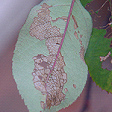
Susceptible Plants
Cherries trees are most susceptible to attack but pears, peaches, plums, quinces, cotoneasters are also attacked.
Cultural Control
Remove by hand. Bare rooted plants are preferred purchases in areas of infestation, because of the risk of pupae in soil. For the same reason, bare soil beneath infested plants may be covered with fly netting, to prevent sawflies from emerging, or the soil may be cultivated to disturb and destroy pupae.
Biological Control
There is a predator wasp (Polistes Paper Wasp) that carries the slug to its nest for its lava to feed on. Several species of bird also feeds on the lava but both wasps and birds tend to feed on heavily infested plants. This is not going to save the appearance of the damaged plant.
Chemical Control
Normally spraying is not required and spraying will kill the wasps that are helping to control the pest. If spraying is required Maldison or Carbaryl may be used.
Note
Always read the label for registration details and direction of use prior to application of any chemicals.
PEST
NAME
Aphids
Various Aphid Species
ORDER
Hemiptera
FAMILY
Aphididae
Description of the Pest
The common name varies and aphids may be referred to as black fly, greenfly, ant cows or plant lice.
These small insects have soft globular body that is from 1mm to 8mm long and vary in colour from green, yellow, black and pink, with the winged forms being elongated. Both adult and nymphs, have piercing and sucking mouthparts.
Aphids are found on buds, flowers, or leaves and stems, preferring soft new growth. On older leaves the aphids are found in protected positions, such as under the leaf. Certain species of aphids form galls as they suck sap and may be found on the roots of the plant. (E.g. Woolly aphids and Black peach aphids)
Most aphids possess a pair of characteristic tubular projections, known as cornicles; these secrete a pheromone and a waxy fluid, which is thought to protect them from some of their predacious enemies.
White exoskeletons, honey dew and sooty mould indicate the presence of Aphids
Balsam Twig Aphid (Mindarus abietinus) is greenish and covered in a white wax and is normally found on the young shoots of conifers bending and killing the needles. It is found on Abies and Picea species.
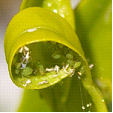 Aphid and their exoskeletons
Aphid and their exoskeletons 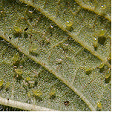 on underside of a leaf
on underside of a leaf
Black Citrus Aphid (Toxoptera aurantii) has a soft plump green body and the black coloured adults may or may not be winged. They feed in groups, curling leaves and producing honeydew attracting sooty mould.
Green Peach Aphid (Myzus persicae) is a soft plump green insect up to 0.2mm long and may be wingless. The nymphs are yellowish green and are responsible for spreading viruses in Dianthus species.
Spruce Gall Aphid (Chermes abietis) form cone shaped galls up to 12mm long resulting from the feeding. The wingless female adult lays eggs on the stems and the immature females overwinter on bud scales. Large infestation will weaken trees such as Picea abies and Pseudotsuga menziesii.
Tulip Bulb Aphid (Anuraphis tulipae) is small, waxy grey coloured and infests the underside of the bulb scales or rhizomes. They occur in the ground or on above ground parts and during storage.
Life Cycle
These insects have a Hemimetabolous life cycle, i.e. The nymphs resemble the adults.
During spring all eggs produced hatch as female nymphs. Adult Aphids are capable reproducing without fertilisation. The males are only produced in some species as the weather cools down, and the day length shortens.
Aphids are capable of giving birth to living young and large populations build up quickly during summer. Over crowding causes the aphids to become smaller, less fertile and produce more winged forms that can migrate to other host plants.
There are many different types of aphids and the life cycle varies from warm to cold climates.
Typical life cycles

Distribution of the Pest
World wide
Period of Activity
In warm climates they are seen throughout the year, but aphids dislike hot dry or cold conditions and heavy rain will decrease the population. In cold areas aphid eggs are laid around a bud base or other protected areas of the plant during autumn and emerge as nymphs during spring, feeding on the new growth.
Numbers build up quickly in the warmer months of the year. Some species feed during winter on Sow thistles.
Susceptible Plants
There is a wide range of plants attacked, from roses to vegetables, shrubs and trees. Certain aphids attack a specific genus while others have a wide range of host plants. Many are capable of transmitting plant virus diseases.
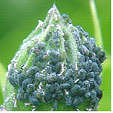 Adults and nymphs feeding
Adults and nymphs feeding 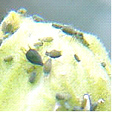 A colony of aphids
A colony of aphids
Acer species are attacked by several aphids including the Norway Maple Aphid (Periphyllus lyropictus) which is a greenish with brown markings and secret honeydew, preferring Acer platanoides. Other aphids include (Drepanaphis acerifolia) and (Periphyllus aceris) which are commonly found on the underside of leaves.
Acer species are also attacked by the Woolly Maple Aphid (Phenacoccus acericola) which covers the undersides of the leaves with a cotton-like mass
Alnus species are infested with the Alder Blight Aphid (Prociphilus tessellates) which is blue-black adult that forms woolly masses on the down-turned leaves. The nymphs overwinter in bark crevices.
Aquilegia species are attacked by several aphids including (Pergandeidia trirhoda) which is a small, flat cream coloured insect that is found on young branches and the underside of leaves.
Betula species may be attacked by the European Birch Aphid (Euceraphis betulae) which is small and yellowish or the Common Birch Aphid (Calaphis betulaecolens) which is large and green producing ample honeydew for sooty mold to grow on.
Callistephus species may be attacked by the Corn Root Aphid (Anuraphis maidi-radicis) causing the plant to become stunted, the leaves wilt and turn yellow. The aphids feed on the roots producing honeydew and are dispersed to other host by ants. It is also attacked by the Potato Aphid (Macrosiphum solanifolii).
Carya species are attacked by Gall Aphids (Phylloxera caryaecaulis) which is found on the leaves, twigs and stems forming galls and turning them black.
Chaenomeles and Gladiolus species, new growth and leaves become infested with the aphid (Aphis Gossypii)
Cupressus macrocarpa may become infested with the Cypress Aphid (Siphonartrophia cupressi).
Cyclamen species are attacked by the aphid (Myzus circumflexus) and (Aphis gossypii) which can infest healthy plants.
Dendranthema, Dianthus and Crocus species are attacked by several types of aphid including the Green Peach Aphid (Myzus persicae) and the Chrysanthemum Aphid (Macrosiphoniella sanborni).
Hibiscus species are attacked by the aphids (Aphis craccivora) and (Aphis gossypii), both congregate towards the branch tips and may cause leaf curl. Normally only seen in sub-tropical climates.
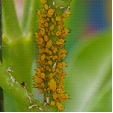 Aphids on a stem
Aphids on a stem 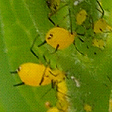 Mandevilla species
Mandevilla species
Larix species is attacked by the Woolly Larch Aphid (Adelges strobilobius). The winged adults deposit eggs at the base of the needles during spring and white woolly areas appear attached to the needles where the adult aphids feed. The young aphids overwinter in the crevices of the bark.
Mandevilla species is attacked by aphids that congregate towards the branch tips and may cause leaf curl.
Pinus species is attacked by several species of aphid including Pine Bark Aphid (Pineus strobi), Pine leaf Aphid (Pineus pinifoliae) and the White Pine Aphid (Cinara strobi).
Primula species are attacked by four species of aphid including foxglove, and green peach aphid.
Rudbeckia, Delphinium, Chrysanthemum and Helianthus species are attacked by a bright red aphid (Macrosiphum rudbeckiae).
Sorbus aucuparia is affected by the Rosy Apple and Woolly Apple aphid which attacked the foliage and young shoots.
Spiraea species are attacked by the Aphid (Aphis spiraecola) which feeds on the young shoots and flowers.
Tropaeolum species are attacked by the Black Bean Aphid (Aphis fabae), which is found in large numbers on the underside of the leaves, turning them yellow and causing them to wilt then die.
Tulipa, Iris, Freesia, Gladiolus and Zephyranthes species are infested with the Tulip Bulb Aphid.
Ulmus species are infected by two types the Woolly Apple Aphid (Eriosoma lanigerum), which curls and kills young terminal leaves and the Elm Leaf-Curl Aphid (Eriosoma ulmi) which occasionally attacks the trees.
Viburnum species are attacked by the Snowball Aphid (Anuraphis viburnicola). This aphid congregates at the end of the branches causing the leaves to curl and become deformed under which they hide.
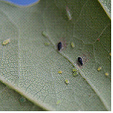 Aphids on Quercus robur
Aphids on Quercus robur
Damage Caused
Buds that have been attacked may not open, leaves and twigs become twisted or distorted and wilt. The aphids also produce honeydew, which is sticky and attracts sooty mould (fungus). This fungus forms a thick layer over the leaf, fruit or stems reducing the plants photosynthesis capability. The sooty mould spoils the plants appearance and its fruit, as does the insects white exoskeletons.
Control
Cultural Control
Aphids may be removed from a plant by hosing them off with water (limited success) or applying soapy water to aphids.. Another organic sprays can be efficient in controlling aphids. Aphids may also be removed physically by hand for small colonies on spine less plants. Species that live under ground are difficult to control but cultivation of the surrounding soil may help in controlling the infestation. (limited mainly to annual or commercial crops)
Reflective mulch around the plants also reduces numbers by repelling the insect this material is available commercially. (Reflective mulches are mainly used in market gardens for avoiding the Green peach Aphids) Resistant rootstocks are available to avoid some root feeding aphid of commercial plants, e.g. Vines and fruit trees
Biological control
Aphids are attacked by several insects includes parasitic wasps or predators such as ladybirds/ lady beetles, hover flies, lacewings, spiders.
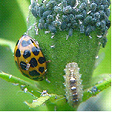
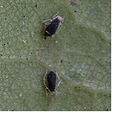 Parasitised aphids
Parasitised aphids
Chemical Control
Aphids may be controlled by spraying with a contact or systemic insecticide. The type of application used will depend on the plant is being attacked.
Aphids can be suffocated and therefore controlled with the use of e.g. White oil, Pest oil, Soapy water from soap such as Lux Flakes ®
Note
It is your responsibility by law to read & follow the directions on the label of any pesticide
Monitoring
Aphid are attracted by yellow colour and traps such as boards painted yellow and covered in glue or sticky substance will attract and trap the insects. There is also a commercially sticky yellow tape that can be attached to susceptible plants
Amendments by B. Sonsie Dip Hort Sc Burnley
PEST
NAME
Caterpillars (General)
Various species
Description of the Pest
There are many types of caterpillars from moths or butterflies, cutworms, bag moths, case moths, leaf rollers leaf skeletonises. The larvae generally eat leaves, seeds, flowers or buds by chewing out pieces. The size of the piece will depend on the size of the caterpillar and generally they are voracious eaters. The method of eating varies such as the leaf skeletoniser which leaves a network of veins or whole leaves are consumed.
The larvae have mainly 4 or 5 pairs of prolegs except Loopers which have 2 -3 pairs of prolegs. The number of prolegs can help in identifying the insect.
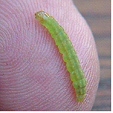 Small and Large Types
Small and Large Types 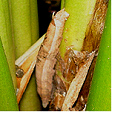
Casuarina Moth (Pernattia exposita) is gregarious, brown with a large head and tufts of hairs that line the slender body. It grows to 25 mm long and forms a tightly woven cocoon on the side of branchlets. The large female adult moth has a stocky body and generally slow moving, the male is smaller.
The larvae cause extensive damage to A. littoralis, A. stricta, C. cunninghamiana, C. glauca, and C. equisetifolia.
The hairy larva feed on the 'leaves" phyllodes, and stems, this can lead to ringbarking and death of branches.
Monitoring
Place sheets on the ground and disturb (shake) the tree for the larva drop to the ground on silken threads.
Spruce Budworm (Choristoneura fumiferana) is a reddish brown with a yellow stripe on its side and chews on the opening buds and the needles of the host. The adult moth is dull grey with brown bands and spots on the wings, appearing in early summer. The larva is very destructive in northern hemisphere coniferous forests.
Banksia Moth (Danima banksiae) is a caterpillar up to 60 mm long and is brown with black and white markings on its sides and when disturbed it arch backwards and reveal an extruded red underside, close to its head. The grey adult moth has an orange coloured body with a wing span that is up to 80mm across with black and white markings.
Banana moth (Opogona sacchari) is in the order Lepidoptera. This nocturnal moth as a wing span up to 25 mm wide and is bright yellowish brown with a dark brown spot on the wings. It has a life cycle that lasts approximately 3 months with the eggs hatching in 12 days and the whitish larva with a reddish brown head is up to, 26 mm long, and lives for 50 days at 15° C. In warmer climates life cycle is quicker with up to eight generations per season. The female moth uses a ovipositor to lay up to 500 eggs in groups of five amongst the crevices of the plant. The voracious larvae tunnel into the plant, avoiding light. In bananas it infests developing fruit and in ornamental plants it prefers the fleshy stems, particularly in cacti, begonias, African violets and is also a serious pest of Pritchardia and Chamaedorea species. Symptoms include tunnelling activity, which may be difficult to see then dead areas appear on the stems. As the caterpillars destroyed xylem tubes leaves begin to wilt and the plant may collapse and die. In European countries it is a glasshouse pest that is controlled chemically.
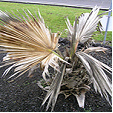 Pritchardi species
Pritchardi species 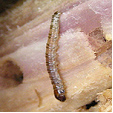 Banana moth larvae
Banana moth larvae
European Pine Shoot Moth (Rhyacionia buoliana) lays eggs on Pinus species during late spring on the new buds and the emerging caterpillars in late summer feed on the shoots causing them to fold and become deformed, eventually dieing. A major problem in the pine forests of the northern hemisphere
Large Grass Yellow Butterfly (Eurema hecabe) is a small attractive yellow butterfly. with a wing span of 40 mm that lays its eggs on the feathery leaves on Acacia species such as A. baileyana, (Cootamundra wattle), A. spectabilis (glory wattle). Other plant foods include Cassia spp, Caesalpinia spp, Senna spp. Albizia julibrissin (silk tree) A. paraserianthes (Albizia) sp Aeschynomene sp (Budda pea), Indigofera australis (Australian indigo's), Sesbania cannabina (yellow pea-bush), Senna surattensis (Glossy shower), Leucaena leucocephala (wild tamarind).
The small lava are up to 15mm long, green with white lateral bands and feed on the leaves at night in small groups, hiding under the leaves during the day. Large infestations may strip trees and require control. The larva of this insect does not feed on grasses. The adults are important pollinators of many Australian native plants. Various sub species of this insect are found through out Asia.
Gypsy Moth (Porthetria dispar) lava is a hairy grey caterpillar that is marked with blue and red dots along its back and can grow to 75mm long. It is capable of defoliating large trees and is a major problem for several species. A major problem in the northern hemisphere.
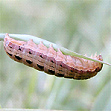 Lawn Armyworm
Lawn Armyworm
Lawn Armyworm (Spodoptera mauritia) is a plump, smooth caterpillar that is darkish brown to black with multiple stripes and pattens along its body. It can grow to 50mm long and tapers from the head. They are gregarious and move around in groups, like an army. If disturbed the larva drop to the ground and curl up, "faking death" The larva pupate in the soil. They are a pest of grasses and monocotyledon crops mainly.
This insect is also found throughout Asia.
Monitoring
Drench a known area with old fashion soap 2L / 1000 cm 2. Note the numbers of larvae emerging.
Oblique-banded Leaf Roller (Choristoneura roseceana) lava feeds on the leaves and forms a nest by drawing the leaf margins together using silk threads. The adult moth is up to 25mm across the wingspan and is reddish brown with three darker brown bands across the wings. This is a problem in the apple growing areas of North America. It feeds on Maples, hawthorns, crab apples, Blackberry (bramble) and raspberries.
Red Humped Caterpillar (Schizura concinna) is a lava has a red head and humps with yellow and black strips on the body. It grows from eggs that were laid on the underside of leaves by the adult greyish brown moth that has a wing span up to 30mm across.
Tailed Emperor Caterpillar (Polyura pyrrhus spp. sempronius) adult is a large butterfly with a wing span up to 110 mm with four long tapering tails and the rear of the wings. The fleshy caterpillar with four obvious backward facing horns on a shield shape head. It is dark green with yellowish bands and transversal stripes over its back and grows up to 80 mm in length.
It is commonly found solitary or in small groups. Found over much on mainland Australia. The adults are attracted to overripe fruits they become drunk on this and so are easy to capture. The larvae feed on many plants including, Acacia baileyana (Cootamundra Wattle, A. spectabilis (Glory wattle), Delonix regia (Poinciana), Cinnamomum camphora (Camphor laurel) Robinia pseudoacacia (Black or false locust) Lagerstroemia indica (Crepe Myrtle), Argyrodendron actinophyllum (Black booyong), Celtis spp (Hackberry), Brachychiton spp (Kurrajongs) Gleditsia triacanthos (Honey locust).
Verbena Moth (Crambodes talidiformis) lays its eggs on the outside of the plant and the small green caterpillar that attacks seed pods by entering and eating the contents. It half emerges while pupating appearing as a small brown bump circled by a black ring. Native to North America
White Tussock Moth (Hemerocampa leucostigma) produces lava that is up to 50mm long. It has a red head with a yellow body that is marked in black and has four tufts of hair. The caterpillars pupate on the branches and the eggs laid by the adult moth overwinter on the trunk and are covered in a white waxy material. They are found on Aesculus species. A pest in North America of Oaks.
Life Cycle
This insect has a Holometabolous life cycle, i.e. it has a larval and a pupal stage.
Distribution of the Pest
Many species are found throughout the world from tropical to temperate regions and most of the adults are capable of by flying
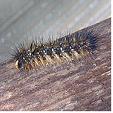 Many hairy caterpillars can be irritating
Many hairy caterpillars can be irritating 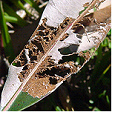 Leaf Skeletonised
Leaf Skeletonised
Period of Activity
Most active during the warmer months from spring to autumn.
.
Damage Caused
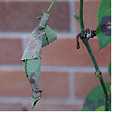 Leaf Rollers
Leaf Rollers
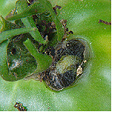 Caterpillar Inside a Tomato
Caterpillar Inside a Tomato
Susceptible Plants
A wide range of native and exotic plants are attacked and can be a major problem in commercial crops or turf grasses. Plants with soft-textured foliage (eg vegetables, some indoor plants) are preferred, but trees and shrubs are commonly attacked.
Malvaceae Abutilon spp, Hibiscus spp and other members of the family are attacked by the castor oil looper, Croton caterpillar (Achaea janata) which feed on leaves. The tip borer Cotton tipworm (Crocidosema plebejana), Rough bollworm (Earias huegeliana) which feeds on young stems, flowers and seeds. A leaf miner (Phyllonorycter spp)
Acer saccharinum and Fagus species are attacked in North America by the Maple Leafcutter (Paraclemensia acerifoliella) that forms a small cocoon in leaves that it skeletonises.
In Australia Case moths and Painted apple moths (Teia anartoides)
Ailanthus altissima is attacked by the Cynthia Moth (Samia cynthia) light green lava, which eats leaves and the Ailanthus Webworm (Atteva aurea) which are olive-brown caterpillars that form web nests in the leaves.
Antirrhinum species are attacked by the Leaf Tier (Udea rubigalis) lava. This caterpillar eats pieces out of leaves and binds them together forming a nest. It is more commonly found in glasshouse culture.
Berberis species may become infested with the Barberry Worm (Omphalocera dentosa). This small caterpillar is black with white spots, up to 14mm long and feeds on young shoots and leaves. It also binds the shoots with a silken thread to form a nest.
Betula species are attacked by the Leaf Skeletonizer (Bucculatrix canadensiella). The small adult moth has brown wings with a whitish underside and its yellow green, 7mm long lava skeletonise the undersides of the leaf turning it brown.
Brachychiton, Senna and feathery-leaved Acacia species are attacked by the Tailed Emperor Caterpillar, particularly in dryer periods.
Catalpa species are attacked Catalpa Sphinx (Ceratomia catalpae). This large yellow and black Caterpillar grows to 76mm long and attacks the leaves. Large infestations can completely stripped a tree and control is carried out by spraying.
Calendula and Canna species are attacked by the Woollybear Caterpillar (Diacrisia virginica) which has yellow and black lines down its body is up to 50mm long and eats the leaves or flower buds. In Canna species the chewed holes tend to be in a straight line across the leaf.
Celtis species are attacked by the Spiny Caterpillar (Nymphalis antiopa) which is reddish, up to 50mm long and feeds on the leaves at the top of branched in groups.
Cheiranthus species are attacked by the Diamond-backed Moth (Plutella maculipennis) lava, which is a small green caterpillar to 14mm long that feeds on the underside of leaves and may form a shot hole appearance. It forms a small cocoon to pupate in and in cooler climates it may be found in glasshouses.
Cotinus, Fraxinus, Betula, Cornus, Crataegus, Aesculus, Tilia, Acer, Quercus and Populus species are susceptible to attacked by the Oblique-banded Leaf Roller (Archips rosaceana)
Iris and Antirrhinum species are attacked by Verbena Moth.
Picea, Abies, Tsuga and Pinus species are attacked by Budworm commonly found in the northern hemisphere.
Populus and Carya species are attacked by the Red Humped Caterpillar which chews the leaves.
Quercus species are attacked by several caterpillars including Saddleback Caterpillar (Sibine stimulea) and Datana Caterpillar (Datana ministra) that feed on the leaves.
Samanea saman is attacked by several caterpillars (Ascalapha odorata, Polydesma indomita and Melipotis indomita). These caterpillars defoliate the tree but cause no long term problems.
Spiraea, Fraxinus, Betula, Cornus, Crateagus, Acer, Quercus and Populus species are attacked by the Oblique-banded Leaf Roller.
Ulmus, Salix, Crateagus, Tilia, Quercus and Populus species, Pseudotsuga menziesii are attacked by the Gypsy Moth (Porthetria dispar).
Ulmus species are attacked by the Spring Cankerworm (Paleacrita vernata), which chews the leaves during spring and the Fall Cankerworm (Alosphila pometaria), which also eats the leaves during autumn. Ulmus species are also attacked by several caterpillars including the lava of the Leopard Moth (Zeuzera pyrina) and the Tussock Moth (Hemerocampa leucostigma).
Cultural Control
Small numbers may be removed by hand and squashed while others species such as the Casuarina Caterpillar drop to the ground when disturbed by hitting with a stick or shaking the plant. On the ground they can be squashed or collected and placed in a bucket of soapy water. All rubbish around plants and glasshouses should be cleared as certain moths overwinter in such places.
Biological Control
There are many natural predators that reduce numbers including birds, lizards, frogs; other predators are wasps, viruses, and fungi.
Chemical Control
The small plant may be sprayed using Pyrethrum-based insecticide to reduce numbers or dusted with an equally environmental friendly chemical. In severe cases crops may be sprayed with Carbaryl.
Note
Always read the label for registration details and direction of use prior to application of any chemicals.
PEST
NAME
Leafcutting Bee
Megachile species
ORDER
Hymenoptera
FAMILY
Megachilidae
Description of the Pest
Adults grow to 15mm in length; they resemble honey bees in size and shape, but are black in colour, with lines of pale hair on their abdomens. They have modified chewing mouthparts. They are solitary, cause little damage, and are often important pollinators.
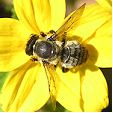
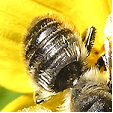 Hair on abdomen
Hair on abdomen
Appearance and Distribution of the Pest
Leafcutter bees occur in Australia, Europe and North America.
Life Cycle
These insects have a Holometabolous life cycle, ie. When metamorphosis is observed during the pupal stage.
Period of Activity
Most active during the warmer months.
Damage Caused
As their name suggests, leafcutter bees cut oval or circular pieces (up to 10mm across) from the margins of the leaves of susceptible plants, which they use to line their nests, which they construct in natural cavities.
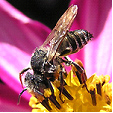
Susceptible Plants
A wide range of ornamentals are susceptible, particularly Rosa, Syringa (lilacs), Camellia, Wisteria, and Prunus species.
Cultural Control
The insects may be swatted when seen but, as they cause little serious damage, this is unnecessary.
Biological Control
There is no effective (or necessary) biological control.
Chemical Control
Not usually indicated.
DISEASE
NAME
Powdery Mildew
Various Powdery Mildew Species
Description
Powdery mildew covers arrange of fungal infections most with simular characteristics of white powdery areas appearing on the leaves and flowers.
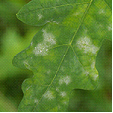
 White powdery area
White powdery area 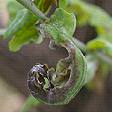
Symptoms
Powdery mildew (Oidium species) affects the following five plant groups with slightly different characteristics.
Cucurbits firstly form white spots on the underside of the leaves. Under optimum conditions the fungus spreads to the upper surface covering the entire leaf causing it to die. It may also extend to the stems slowing the growth of the plant and may reduce the size of the fruit.
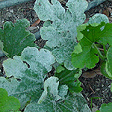
Grape leaves, flowers and fruit are attacked with the appearance of greyish-white powdery spots. Infected flowers set poor quality fruit and infected fruit splits open and dries out.
Pawpaw leaves become infected on the underside at first then spreading covering the entire leaf. The fruit forms irregular light grey spotted areas that damages the surface and under the surface causing the fruit to misshapen and reducing its market value.
Rose leaf and buds are covered in a fine white powdery coating and in severe cases it extends to the stems. When young leaves are infected they become distorted and older leaves develop blackened areas. Infected flower buds may fail to open and opened blooms may be discoloured or distorted.
Strawberries show different signs of infection with the leaf margins first rolling upwards then developing purplish irregular blotches along the veins. The infected flowers may fail to set fruit and if fruit is produced it is small, hard fails to ripen. Semi mature fruit that is infected has dull appearance and may form cracks or split open.
The Powdery Mildew (Sphaerotheca lanestris) infects leaves and twigs. The under side if the leaf firstly has a white mealy growth that matures to felt-like brown mycelium that can cover the entire leaf, and the twig tips. It is only one of the many types that infect Quercus species.
Source and Dispersal
The spores overwinter in fallen leaves, dormant buds, seed and infested plants. It is dispersed by wind.
Favoured Conditions
Generally it prefers warm humid conditions, but failing to germinate when it is raining. The fungus that attacks Pawpaw prefers cooler conditions disappearing in the warmer months.
Affected Plants
There are many plant species ornamental trees and shrubs that are attacked by Oidium species including; Roses, African Violets, Cucurbits, Grapes, Pawpaw, Strawberries, Hydrangeas, Ajugas, Antirrhinum, Oaks and Photinias.
Acer species are infected by the powdery mildews (Uncinula circinata) and (Phyllactinia corylea) but are not normally serious.
Aesculus species are infected by the powdery mildew (Uncinula flexuosa) which forms a white mold on the underside of the leaves.
Arenaria,Cuphea, Erica and Eschscholtzia species are infected by the powdery mildew (Erysiphe polygoni). This fungus is greyish or white and covers leaves or young shoots. Heavenly infected leaves turn brown and fall from the plant. The plant eventually dies.
Aster species are infected with the powdery mildew (Erysiphe cichoracearum) which is more prevalent on the lower part of the plant.
Ceanothus, Corylus, Platanus, Syringa and Weigela species are infected by the powdery mildew (Microsphaera alni) particularly London Plane. The mycelium forms a felt-like cover on the leaves.
Celtis species are susceptible to the powdery mildew (Uncinula parvula) and (Uncinula polychaete). This fungal problem can affect either side of the leaf, which can have spots or be completely coved in mildew. The fruiting bodies appear on the opposite side of the mildew.
Cornus species leaves are infected by the powdery mildew (Microsphaera alni) and (Phyllactinia corylea), covering the leaves in a whitish fungus.
Dahlia species are infected by the powdery mildew (Erysiphe cichoracearum) that forms white powdery areas on the leaf surface.
Lagerstroemia species are infected by the powdery mildew (Uncinula Australiana) that forms white powdery growth on the leaves and may also distort the infected foliage.
Populus and Salix species are infected by a white powdery mildew (Uncinula salicis) that produces black fruiting bodies with a curled tip, but is not normally a major problem.
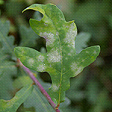
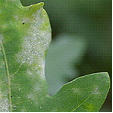 Quercus robur
Quercus robur
Quercus species are susceptible to several powdery mildew fungi including (Sphaerotheca lanestris), (Erysiph trina) and (Phyllactinia corylea). Generally white mealy growth appears on the leaves, normally on the underside turning the infected areas brown and then the leaf dies. The infection may spread to the twig tips causing dieback. Control may be difficult and unwarranted on large trees but nursery stock may be sprayed with a fungicide during susceptible periods.
Rosa species are also infected by the powdery mildew (Sphaerotheca pannosa).
Rudbeckia and Senecio species are covered in white fungus (Erysiphe cichoracearum) which infects leaves, flowers and stems. This results in the plant becoming stunted.
Senecio species are infected by the powdery mildew (Sphaerotheca fuliginea) which forms circular white powdery areas on the leaves.
Spiraea species are infected by the Powdery Mildew (Microsphaera alni) and (Podosphaera oxyacanthae).
Ulmus and Rhododendron (Azalea) species are also infected by (Microsphaera alni). Circular patches of white powdery growth appear on the leaves.
Veronica species are sometimes infected by the powdery mildew (Sphaerotheca humili) causing a white coating to appear on the leaves. Not normally a major problem.
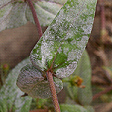
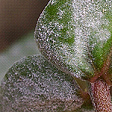
Zinnia elegans are commonly infected by the powdery mildew (Erysiphe cichororacearum), which appears on both sides of the leaves as a greyish powdery cover and may be transmitted by seed.
Non-chemical Control
Choose less susceptible species and when planting space the plants to allow good air circulation. Avoid overwatering and try to keep the foliage dry. Affected plants may be dusted with powdered sulphur or sprayed with a milk mixture to discourage mildew. Vegetables that are infected with mildew should be removed and replaced with new young plants, as they are more resistant to infection.
Chemical Control
Prenatitive spraying during warm humid conditions using a suitable fungicide such as wettable sulphur, bitertanol, carbendazim, fenarimol and triforine helps control the problem.
Note
Always read the label for registration details and direction of use prior to application of any chemicals.
DISEASE
NAME
Leaf Spot (General)
Various Leaf Spot Species
Description
There is a wide variety of fungal leaf spots that infect perennials, shrub and trees. Some are specific to the host while others can affect a range of plants.
Symptoms
Generally light brown to purplish or blackish spots appear on the leaf and form concentric rings of fruiting bodies. The spots may leave holes, perforating the leaf or expand with pale green to yellowish margins and when the holes merge the leaf normally dies. There are many different types of leaf spot, some are discussed below.
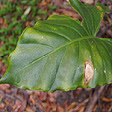 Alocasia species
Alocasia species 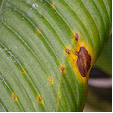
Alternaria Leaf Spot (Alternaria nelumbii) forms a small reddish brown spots that are boarded in light green, and as they develop in size the leaf curls and dies from the margin inwards. Normally occurs on Nelumbo species (water lilies).
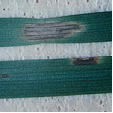 Helminthosporium Disease
Helminthosporium Disease
Helminthosporium Disease (Bipolris species), (Drechslera species) and (Exserophilum species) are responsible for several leaf spots that occur on all Turf Grass species. Generally they form black or white spots that may be faded and produce masses of spores in the thatch during late summer, under humid conditions. The life cycle is short and when conditions are favourable spores are splashed onto the foliage from the thatch, causing wide spread infection. Cynodon dactylon (common couch) is most susceptible and found in bowling or golf greens where it is a serious problem.
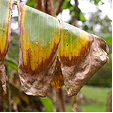 Banana Leaf Spot
Banana Leaf Spot 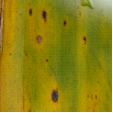
Banana Leaf Spot (Mycosphaerella musicola) is found on many species of banana causing pale yellow streaks on the young leaves to turn brown with dark spots. The leaf then becomes dried, brown and dead commencing from the margins, eventually the leaf dies. Control requires removal of infected foliage or the spraying of a fungicide and fungicides should not be used during the fruiting period.
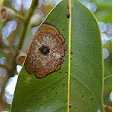
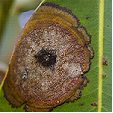 Lophostemon confertus (Brush Box)
Lophostemon confertus (Brush Box)
Leaf Spot on Brush Box (Elsinoe species). This is a casual fungus that attacks the epidermal layer of the leaf, forming circular spots that are up to 25mm across and are often restricted by the main vein. These spots are a dull yellowish brown but can also have purplish patterns. A leaf may have more than one spot develop on its surface and normally appears on scattered leaves throughout the tree. This doesn't affect the vigour of Lophostemon confertus.
Palm Leaf-scab (Graphiola phoeicis) appears as yellow spots and develop into scabs or warts that are outwards hard and dark but with a soft centre with powdery yellowish brown spores. The infected leaves eventually die.
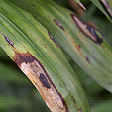 Palm Leaf Spot, Chamaedorea elegans
Palm Leaf Spot, Chamaedorea elegans
Palm Leaf Spot (Pestaloptiopsis species) appears as a small spot with a dark centre on the leaves and affects palms that are growing in shaded humid positions and normally control is not required, though infected fronds should be removed.
Source and Dispersal
Infection source is other contaminated plants and the spores are spread by wind or by splashing water. The fruiting bodies are black spots that appear on the damaged tissue releasing spores.
Favoured Conditions
This fungus prefers a warm humid environment and leafy plants with soft new growth, particularly if they are crowded.
Affected Plants
There are many ornamental and native plants that are hosts to a wide range of fungal leaf spots. Some specific ones are listed below. Plants such as Cornus or Paeonia species are infected by a large variety of leaf spots, while other plants attract a specific leaf spot.
Generally a healthy plant can tolerate fungal leaf spot attack, though it may make the plant look unsightly. In trees and shrubs it is difficult to control and generally not necessary, but in perennials and annuals control may be necessary in order to save the plant.
Acalypha and Arctotis species are infected by up to three leaf spots including (Cercospora acalyphae) and (Ramularia acalyphae) that rarely require control.
Acer species are infected by Purple Eye (Phyllosticta minima) which forms spots with brownish centres and purplish margins causing the death of the leaves.
Acer species are also infected by Tar Spot (Rhytisma acerinum) which forms round black spots that have yellow margins. Not normally seen on cultivated trees, but seen in forests.
Adiantum, Asplenium, Blechnum, Cyathea, Davallia, Nephrolepis, Platycerium, Polypodium and Pteris species are infected by the leaf spot (Pseudocercopora species) which forms circular brown spots on the fronds and heavy infection can defoliate a plant.
Aesculus species are occasionally infected with the leaf spot (Septoria hippocastani) which forms small brown spots.
Agave species are susceptible to the leaf spot (Coniothyrium concentricum), which appear as greyish spots up to 20mm (1in) across with concentric rings and black fruiting bodies. Affected leaves are destroyed as the infection spreads.
Albizia julibrissin is susceptible to the fungal leaf spot (gloeosporium aletridis), which does not normally require control.
Amelanchler, Chaenomeles, Crataegus and Rhaphiolepis species Mespilus germanica are infected by the leaf spot (Fabraea maculata) which may cause considerable damage during wet periods.
Aquilegia species can be infected by three types of Leaf Spot including (Ascochyta aquilegiae), (Cercospora aquilegiae) and (Septoria aquilegiae), normally appearing during humid conditions forming spots on the leaves.
Arbutus species are infected by two leaf spots (Septoria Unedonis) which produces small brown spots on the leaves and (Elsinoe mattirolianum).
Arctostaphylos manzanita is infected by the leave spot (Cryptostictis arbuti) which damages leaves but is not normally detrimental to the shrub.
Aspidistra species are infected by the leaf spot (Colletotrichum omnivorum) causing whitish spots on the leaves and petiole.
Aster species are infected by many leaf spots including (Alternaria species), (Cercosporella cana), ( Ovularia asteris) and (Septoria asteris).
Aucuba species are infected by several leaf spots, usually as a secondary infection after aphid attack. These include (Phyllosticta aucubae) and (Phyllostica aucubae).
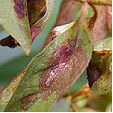
 Azalea
Azalea
Azalea (Rhododendron species) are susceptible to Leaf Scorch (Septoria azalea). This fungal disease forms reddish- brown spots which expand and engulf the leaf, with fruiting bodies appearing in the centre. Infected leaves die, then fall and the branchlets wilt. This problem is more serious during wet periods and may require control using a fungicide.
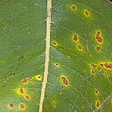 Banksia robur
Banksia robur
Banksia species are infected by several leaf spots causing chlorotic areas that have brown centres and is not normally a major problem for the plant.
Betula species may be infected by the Leaf Spots (Gloeosporium betularum) that forms brown spots with darker margins and (Cylindrosporium betulae) that also forms brown spots with faded indefinite margins.
Bougainvillea species are infected by the leaf spot (Cercosporidium bougainvilleae) which forms rounded spots with dark margins that yellowish ting. Infected leaves die and fall from the plant.
Calendula species are infected by the Leaf Spot (Cercospora calendulae) which rapidly infects the plant spotting the leaves and killing the plant.
Callicarpa species may be infected by the leaf spot (Atractilina callicarpae) forming irregular brownish spot or (Cercospora callicarpae) which can defoliate the plant in subtropical climates.
Campsis species may be infected by several fungal leaf spots including (Phyllosticta tecomae), (Septoria tecomae) and (Cercospora duplicata).
Carpinus species are infected by the leaf spots (Gloeosporium robergei), (Gnomoniella fimbriata) and (Septoria carpinea), all are minor infections not normally requiring control.
Carya species are infected by several leaf spots including (Gnomonia caryae) that infects leaves with irregular reddish spots on the upper surface with corresponding brown spore producing spots on the underside. It also has a secondary spore release that occurs on the dead leaves where it over winters. Other leaf spots include (monochaetia desmazierii) and (Marssonina juglandis).
Ceanothus species are susceptible to the leaf spot (Cercospora ceanothi) and (Phyllosticta ceanothi) both are of minor importance not requiring control.
Celtis species are infected by many leaf spots including (Cercosporella celtidis), (Cylindrosporium celtidis), (Phleospora celtidis) and (Septogloeum celtidis).
Chrysanthemums species are infected by the leaf spot (Septoria species) which forms yellow spots appear toward the edge of the leaves; these become enlarged brownish patches with yellow margins. Damaged areas may converge and in severe attacks and the leaves may fall prematurely or flower production is reduced.
Clematis species are infected by the fungal disease (Ascochyta clematidina) which may cause stem rot or leaf spots that are water soaked areas with reddish margins. The infection spreads from the leaves to the stem causing wilting and eventually girdling the stem killing the plant. There are many fungal leaf spots that infect this plant including (Cercospora rubigo) and (Septoria clematidis)
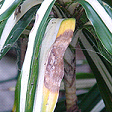 Dracaena deremensis
Dracaena deremensis
Cordyline and Dracaena species may be infected by the leaf spot (Phyllosticta maculicola) which forms small brownish spots that have yellowish margins and has black fruiting bodies that forms coils of spores. These plants are also susceptible to other leaf spots such as (Glomerella cincta) and (Phyllosticta dracaaaenae). Keep foliage dry to avoid infection.
Cynodon dactylon, Pennisetum clandestinum and many other Turf Grasses are susceptible to Helminthosporium Disease.
Daphne species are infected by the leaf spot (Gloeosporium mezerei) and (Marssonina daphnes) both of which form thickish brown spots that are seen on both sides of the leaves. Infected leaves turn yellowish before dieing.
Dendranthema species are infected by many leaf spots such as (Septoria chrysanthemi) which first forms yellowish spots up to 25mm (1in) across that become black. Infected leaves die prematurely and persist on the plant.
Dianthus species may be infected by the leaf spot (Septoria dianthi). It forms light brown rounded spots that have a purplish border. The scattered spots on the lower leaves can also be found on the stems and the spores are dispersed by water from the tiny black fruiting bodies.
Dieffenbachia species are infected by several leaf spot fungi including (Cephalosporium species) and (Myrothecium species).
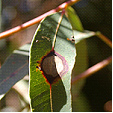 Eucalyptus species
Eucalyptus species
Eucalyptus species are infected by many fungal leaf spots such as (Mycosphaeralla species), (Hendersonia species) and (Monocheatia monochaeta). Generally leaf spots appear on the juvenile or new leaves causing brownish spots that enlarge and may have a purplish halo around the margin. Mature adult leaves are not normally infected and the trees rarely require control measures.
Fern species are infected by the leaf spot, (Alternaria polypodii). This fungus appears as brown circular or oblong spots that congregate along the margins of the pinnae causing the fronds to turn brown and die. It is spread by wind currents from plant to plant and control methods include removing infected fronds and maintaining a drier atmosphere.
Ficus species are infected by various fungal leaf spot including (Pseudocercospora species). Generally the fungal attack forms circular or irregular dark coloured spots on the leaves eventually causing them to fall prematurely.
Ficus elastica is susceptible to many fungal leaf spots including (Alternaria species), (Leptostromella elastica) and (Phyllosticta roberti).
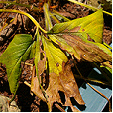
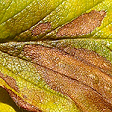 Strawberry
Strawberry
Fragaria x ananassa (Strawberry) is infected by the fungal leaf spot (Mycospharella fragariae). The mature leaf is initially infected with well defined brown spots that that turn light grey with red-purplish margins. As the spots merge they form large brown blotches and the leaf turns yellow then dies. This fungal attack normally occurs on plants in poor health and can be a serious problem early in the season seriously damaging stock.
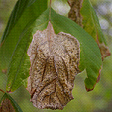 Fraxinus species
Fraxinus species
Fraxinus species are infected by the leaf spot (Gloeosporium aridum) giving the leaf a scorched appearance as large blotches appear from the margin or apex and turn brown with a papery texture. It is more prevalent during rainy periods and infected leaves fall prematurely. Collect and depose of fallen leaves otherwise control is not normally required.
Fuchsia species may be infected by the leaf spot (Septoria species) or ( Cercospora species), both form spots with dead centres and dark margins.
Gladiolus species are infected by Hard Rot or Leaf Spot (Septoria gladioli). On the corms reddish brown circular water soaked spots become large and sunken. These areas dry out and form obvious margins. The leaves may also have these symptoms but is not commonly seen.
Hemerocallis species are infected by several leaf spots including (Cercospora hemerocallis) and (Heterosporium iridis). These may be in the form of black spots or brownish spots that converge killing the leaf. Infected leaves should be removed and burnt.
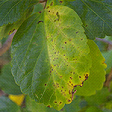 Hibiscus species
Hibiscus species
Hibiscus rosa-sinensis, Hibiscus syriacus and Hibiscus tiliaceus are susceptible to several fungal leaf spots including (Ascochyta abelmoschi), (Cerospora kellermanii) and (Phyllosticta hibiscina). All cause spotting or blotching of the leaf surface; remove and destroy infected parts.
Hydrangea species are infected by four fungal species including (Ascochyta hydrangeae), (Phyllosticta hydrangeae) and (Septoria hydrangeae).
Iris species are infected by several fungal leaf spots including (Alternaria iridicola) and (Macosphaerella species).
Iris species are also infected by the leaf spot (Didymellina macrospore) that forms greyish spots with brown water soaked borders and coalesce on the upper part of the leaf. This casual organism commonly occurs after flowering killing the leaves but will not infect the bulbs. The bulbs become weak over several seasons due to the decreased foliage.
There is also a Bacterial Leaf Spot (Bacterium tardicrescens) that is commonly mistaken as a fungal problem causing translucent spots that coalesce and involve the entire leaf. Normally found on Iris species.
Laburnum anagyroides is infected by the Leaf Spot (Phyllosticta cytisii). The leaf forms light grey spots with no definite margin and mature to brown. The black fruiting bodies appear as dots in the centre of the spot.
Leucanthemum species are infected by the leaf spot (Cerocspora chrysanthemi) and (Septoria leucanthemi).
Magnolia species are susceptible to many species including (Alternaria tenuis), (Mycosphaerella milleri) and (Phyllosticta species). Leaves generally turn brown from the apex or margins turning brown or spots appear on the leaf surface and leaves become yellow before withering and dieing. Normally the make the tree look poorly but have little effect on its growth. Control is not normally required.
Nerium oleander is susceptible to several fungal leaf spots including (Cercospora nerella), (Cercospora repens), (Gloesporium species) and (Phyllosticta nerii). Infected leaves should be removed but generally control is not required.
Nyssa sylvatica is infected by the leaf spot (Mycosphaerella nyssaecola) forming irregular purplish blotches.
Orchids such as Cattleya, Cymbidium, Cypripedium, Dendrobium, Epidendrum, Paphiopedilum, Phalaenopsis and Zygopetalum species are infected by several leaf spots including (Cerospora, Colletotrichum and Phyllosticta species). Normally forming dark or dead, circular or irregular areas on the leaves.
Palms such as Syagrus, Howea, Phoenix, Roystonea and Washingtonia species are infected by Leaf-scab (Graphiola phoeicis).
Palms such as Archontophoenix, Caryota, Chamaedorea, Cocos, Dypsis, Howea, Liculia, Linospadix, Livistona, Phoenix, Ptychosperma, Rhapis, Roystonea, Syagrus, Washingtonia and Wodyetia species are susceptible to several fungal leaf spots including;
(Bipolaris spp.), (Cylindrocladium spp.), (Colletotrichum spp.) and (Pestalotiopsis spp.).
Generally the circular leaf spots are brown and may have a yellow halo such as Palm Ring Spot (Bipolaris incurvata). They vary in size from small to large depending on the species. When a plant is healthy it recovers from attack, but heavy infections can defoliate, causing the collapse of the plant.
Palms are also infected by the Brachybasidium Leaf Spot (Brachybasidium pinangae). This fungus forms angular leaf lesions that produce fruiting bodies on the underside and is commonly found on Archontophoenix species.
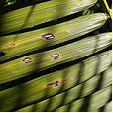
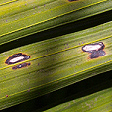 Archontophoenix cunninghamiana
Archontophoenix cunninghamiana
Passiflora species are infected with many types of leaf spot such as (Alternaria passiflorae).
Phoenix species are susceptible to False Smut (Graphiola phoenicis). This fungus forms yellow leaf spots that become hard with a raised with a blackish scab, which produces masses of powdery spores that are thread-like.
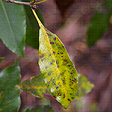
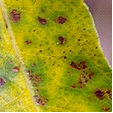 Pittosporum species
Pittosporum species
Pittosporum species are susceptible to the leaf spots (Alternaria tenuissima), (Phyllostica species) and (Cercospora pittospori). Circular or angular dark spots appear on the leaves and are surrounded by necrotic areas that are yellowish. Generally removal of infected leaves is adequate control.
Poa species and other cool season grasses are infected by Winter Fusarium Leaf Disease (Fusarium species), which causes small pale spots that are water soaked to appear on the leaves that turn red-brown. Infected leaves become bleached then wither and die, but the infection will not affect the crown or roots of the plant. It can be identified by pink, cotton-like mycelium and the plant prefers cold wet weather.
Populus species are infected by several fungal leaf spots including (Ciborinia bifrons, Ciborinia confundens), and (Mycosphaerella populicola).
Prunus species are infected by several leaf spots including (Cercospora circumscissa and Septoria ravenelii).
Pseudotsuga menziesii Douglas Fir is infected by the Leaf Cast (Rhabdocline pseudotsugae) Symptoms include the needles becoming yellowish at the apex and extending down the needle and spreading to others during moist spring weather turning them brown. Brownish scorched areas are noticeable on the tree from a distance. Control; is not normally required for mature trees but nursery stock may require spraying with a copper based fungicide.
Psidium guajava (Guava) is infected by (Glomerella cingulate). This fungus courses spots to appear on leaves and mummifies and blackens immature fruit or rots mature fruit. This fungus can devastate a guava crop.
Quercus species are infected by several types of leaf spot including (Cylindrosporium microspilum) and (Marssonina martini). These attacks tend top take place later in the season and normally not detrimental to the tree.
Rhododendron species are infected by a large variety of fungal leaf spots including (Cercospora rhododendri) and (lophodermium melaleucum)
Salix species are infected by several fungal leaf spots including (Ascochyta salicis) and (Septogloeum salicinum).
Senecio species are infected by the fungal leaf spot (Alternaria cinerariae) and (Cercospora species), forming dark rounded or angular spots.
Spiraea species are attacked by the fungal leaf spot (Cylindrosporium filipendulae).
Stenotaphrum secundatum (Buffalo) turf grass is susceptible to Grey Leaf Spot (Pyricularia grisea) in domestic and commercial situations devastating lawns. This fungal disease infects the stems and leaves with small brown lesions that enlarge rapidly forming grey-brown spots that have darker borders or surrounded by yellow chlorotic areas. This infection is commonly found on newly laid turf but will also infect established lawns. It is most prevalent during warm humid periods in soil with a high nitrogen level.
Syringa species are attacked by up to six species of leaf spot including (Cercospora lilacis) and (Phyllostica species).
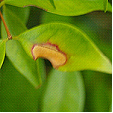 Syzygium species
Syzygium species
Syzygium species are infected by fungal leaf spots but normally control is not required.
Tagetes species are infected by the leaf spot (Septoria tageticola), which starts at the base and moves progressively up through the plant, covering the leaves in grey to black spots.
Trillium species are host to several leaf spots, including (Colletotrichum peckii) (Gloeosporium Trillii) (Heterosporium trillii).
Ulmus species are infected by many fungal leaf spots including (Gnomonia ulmea) and (Cercospora sphaeriaeformis).
Veronica species are infected by the leaf spot (Septoria veronicae). The symptoms include small violet to brown spots appear on the upper surface of the leaf and correspondingly yellowish brown on the underside. The spots converge forming a scorched shot-hole appearance and eventually death of the leaf.
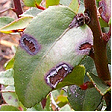 Vaccinium ovatum
Vaccinium ovatum
Vaccinium ovatum is infected by the leaf spot (Rhytisma vaccinii) and (Dothichiza caroliniana).
Vicia species are infected by the leaf spot (Erostrotheca multiformis), which forms greyish spots that enlarge and may defoliate the plant.
Wisteria species are infected by three fungal leaf spots (Phyllostica wisteriae), (Septoria wisteriae) and (Phomatospora wisteriae).
Non-chemical Control
Remove and destroy infected plant material and avoid overhead watering. When planting select infection resistant varieties. Practice crop rotation and add pot ash to the soil to decrease the plants venerability to the disease. Many species of fungus overwinter in fallen leaves, remove and destroy any litter under the plant.
Winter Fusarium Leaf Disease in Turf Grasses can be minimised by aerating the soil, reducing thatch and avoid excessive nitrogen in the soil.
Chemical Control
Protective fungicides such as zineb or copper oxychloride should be sprayed at the first sign of infection and cuttings should be sprayed as they start to grow.
Note
Always read the label for registration details and direction of use prior to application of any chemicals.
DISEASE
NAME
Canker (General)
Various Canker Species
Description
This is a fungal problem that enters the plant through wounds causing dieback of twigs and stems.
Symptoms
The stems become discoloured (pale brown) usually from a pruned point, working its way down the stem and normally intersecting or surrounded with live cambium. The bark splits or cracks, foliage dies and infected areas can develop tiny black fruiting bodies. Heavy infected plants eventually die, though certain varieties are resistant halting the spread of the infection.

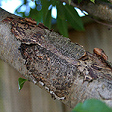
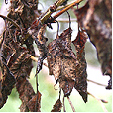
Black Canker (Phyaslospora miyabeana) forms dark brown spots with concentric rings on the upper leaf surface and grey spots on the stems. The tiny black fruiting bodies develop in the stem lesions. It is found on Salix species and persistent attacks will kill the tree.
The Canker (Cytospora valsa) causes the browning and death of branches in Picea abies and Picea pungens. This infection occurs normally from the base of the tree with infected needles falling, and white resinous patches appearing on the bark accompanied by cankers with tiny black fruiting bodies.
The Canker (Corynneum cardinale) is a casual fungus that invades wounds and infects living bark and associated cambium turning the foliage yellowish. As it spreads it girdles the branch killing it and ultimately the top of the tree dies out. Cankers eventually form in the trunk and ooze resin. It is found on Cypress.
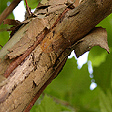 Platanus x hybrida
Platanus x hybrida
Cankerstain (Ceratocystis fimbriata f. platani) forms sunken cankers on the trunk and large limbs forming longitudinal cracks and roughened bark. Infected areas form callus around the margins which dies off and when cut open, dark coloured streaks are revealed extending to the central pith. These streaks then radiate out into uninfected wood resulting in the thinning of the crown and producing unusual small leaves. It is normally transmitted through poor tree surgery techniques and infected tools.
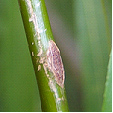 Cytospora Canker
Cytospora Canker
Cytospora Canker (Cytospora chrysosperma) is a casual fungus that infects the young twigs, then moving to the stems, branches and trunk causing brown sunken areas to appear that is covered in red pustules. The fungus tends to attack trees that are in poor health. Control requires the removal of infected branches and improved culture to regain the plants vigour. Sorbus aucuparia, Salix and Popular species are susceptible.
 Cypress Canker
Cypress Canker
Cypress Canker (Seiridium species) enters the plant through wounds or through insect damage causes the bark to spread revealing brown powdery spores that are accompanied by oozing resin. The canker eventually girdles the branch or trunk causing ringbarking and the death of the plant.
Nectria Canker (Nectria Cinnabarina) forms cankers on the twigs and small branches producing red fruiting bodies and eventually killing the tree. It is found in many parts of the world infecting a range of trees including hardwoods.
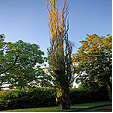
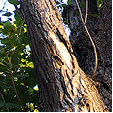
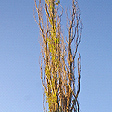 Populus nigra
Populus nigra
Poplar Canker (Cryptodiaporthe populea) infects the cambium layer damaging the bark and sapwood where the elongated sunken canker forms. Branches are girdled causing the upper portion to die off. This is a serious problem for Populus nigra var. Italica entering the plant through wounds or the leaves then spreading to twigs and branches. Control is difficult as removal of infected parts will not eradicate the problem, but encourage it. Young plants may be sprayed with a copper based fungicide to reduce leaf infection and heavily infected plants should be removed the burnt.
Stem Canker of Red Flowering Gum (Sporotrichum destructor) enters through wounds in the bark forming cankers in the trunk and branches, splitting the bark apart, revealing the wood and infesting the surface with powdery spores. This infection causes the leaves to wither and then the branches die, eventually killing the tree.
Stem Canker (Strumella coryneoidea) is a casual fungus that forms on the trunks of trees as a smooth, dispersed or sunken infection. On mature trees the infection sheds the bark with the canker forming callus tissue around the margins and the centre being exposed. These cankers then tend to extend up and down the trunk, only girdling over a long period of time. It is found on Quercus, Fagus, Aesculus species, and Acer rubrum , Nyssa sylvatica, Carya ovata and Morinda citrifolia.
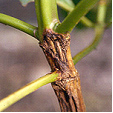
Source and Dispersal
The spores are found on infected dead plant material and can be dispersed by wind and with splashing water.
Favoured Conditions
It prefers a warm humid conditions and plants that have a wounds derived from poor pruning techniques and insect or other damage, especially if water is allowed to settle on the wound.
Affected Plants
Cankers may infect a wide range of trees and shrubs with some species being specific to its host. Examples are listed below.
Abies species are infected by several cankers including (Cytospora pinastri), (Cryptosporium macrospermum) and (Scoleconectria balsamea). These fungi form dead sunken areas on the trunk and branches.
Alnus species are infected by a few cankers including (Nectria coccinea) and (Physalospora obtusa) these attack the branches causing die back.
Betula species may be infected by the Canker (Nectria galligena) that occurs in the forks of trees causing splitting and cracking of the bark by swelling, to reveal the canker. Callus rings may form around the affected areas as a defence mechanism triggered by the tree.
Buxus species are infected by the Canker (Pseudonectria rousseliana) which shows signs of poor new growth during spring with the leaves turning from light green to a tan colour. These leaves tend to lay flat along the stems and reddish pustules appear both on the stems and leaves. The bark becomes loose and on inspection reveals a darkish colour underneath. It is difficult to control and the canker can kill the plant.
Castanea species are infected by the Twig Canker (Cryptodiaporthe castanea), a fungal problem that causes significant damage to the twigs and small branches, but tends to attack stressed trees.
Cercis and Ribes species are infected by the Canker (Botryosphaeria ribis) which forms small sunken areas on the stems causing wilting and eventually killing the branch by girdling. The cankers turn the bark black then split it open and the adjoining wood becomes discoloured. This is a serious problem for this and many other plant species.
Cotoneaster, Betula, Catalpa and Aesculus species are infected by the canker (Physalospora obtusa).
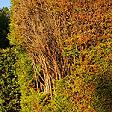
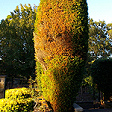 Cypress Canker
Cypress Canker
Cupressus species and Chamaecyparis lawsoniana are susceptible to Cypress Canker (Seiridium species) which causes leaf browning and then girdles the trunks resulting in ringbark. There is also another Canker (Coryneum cardinale) that has simular characteristics and is found in the northern hemisphere.
Cupressus sempervirens is infected by Cytospora Canker (Cytospora cenisia var. littoralis).
Larix species are susceptible to several fungal cankers including (Trichoscyphella wilkommii), (Trichoscyphella ellisiana), (Aleurodiscus amorphus), (Leucostoma Kunzei) and (Phomopsis spp.)
Nyssa sylvatica is attacked by three cankers including (Strumella coryneoidea).
Pinus species are infected by many types of cankers.
Platanus species are infected by Cankerstain.
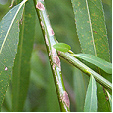 Cytospora Canker on Salix babylonica
Cytospora Canker on Salix babylonica
Pseudotsuga menziesii Douglas Fir is attacked by several cankers including (Cytospora species), (Dasyscypha ellisiana), (Dasyscypha pseudotsugae), (Phacidiopycnis pseudotsugae) and (Phomopsis lokoyae). These infections normally do not require control and are more prevalent on the coastal form.
Salix and Populus species are infected by several cankers including Cytospora Canker (Cytospora chrysosperma), Hypoxylon Canker (Hypoxylon pruinatum), Septoria Canker (Mycosphaerella populorum) and Branch Gall (Macrophoma tumefaciens). Many of these fungi can cause the death of the plant.
Thuja orientalis, Cupressus and Juniperus species are infected by the canker (Corynneum cardinale).
Tilia and Acer species are infected by (Nectria cinnabarina) attacking twigs or branches.
Tsuga species are infected by several cankers including (Dermatea balsamea) and ( Cytospora species).
Ulmus species are infected with up to eight fungal cankers including (Apioporthe apiospora) and (Nectria coccinea).
Vaccinium ovatum is infected by the canker (Coryneum microstictum) which attacks the stems.
Vinca species are infected by canker-dieback (Phomopsis livella) causing the shoots to wilt, turn brown and die. This can reduce the plant to ground level, and normally occurs during rainy periods.
Non-chemical Control
It is very difficult to control and correct pruning techniques with sharp tools for repairing wounds or prune well below the infected areas. Ensure that there are no ragged edges on the cuts and the angle should cut allows water to run off or dress the wound. Plant resistant varieties when available. Heavily infected trees should be removed to avoid spreading the disease.
Improve the culture of the affected plant to increase vigour for greater resistance.
Chemical Control
There is no satisfactory chemical control and prevention is imperative.
Note
Always read the label for registration details and direction of use prior to application of any chemicals.
DISEASE
NAME
Verticillium Wilt
Verticillium dahliae
Description
This is a soil based fungus that attacks the root hairs and travels throughout the plants vascular system.
Symptoms
With annuals or perennials such as dahlias lower leaves wilt, turn brown and die and the stems appear normal until the base splits open and turns blackish. This may extend throughout, killing the plant. With larger trees the fungus causes the leaves at the end of the branches wilt and die off.
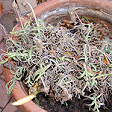
Verticillium albo-atrum is a soil born fungus that normally infects the roots acting on the water conducting cells by restricting flow causing the plant to wilt. On trees the leaves suddenly wilt and die. This may happen on individual branches on one side of the tree. Other symptoms are leaves form smaller than usual turning yellow and the plant may not shoot the following season. Trees may die over a short or long period of time depending on the severity or number of infections it has incurred and Acer saccharinum and Catalpa species are most susceptible.
Source and Dispersal
It is found in the soil and dispersed by movement of soil i.e. in containers or on machinery. The fungus may survive in the soil for many years.
Favoured Conditions
Moist poorly drained soils are prone to fungus and during the cooler humid months the fungus is most active.
Affected Plants
There is a wide range of hosts including tomatoes, potatoes, chrysanthemums and other perennials. It also found in shrubs and trees.
Acer, Achillea, Koelreuteria , Paeonia and Syringa species are infected by Verticillium albo-atrum causing wilting. Erythrina x sykesii may also become infected.
Berberis species are infected with Verticillium albo-atrum causing the leaves to turn brown, shrivel then die.
Non-chemical Control
Cultivate soil to improve drainage and aeration. Cut down and destroy any infected plant material and when taking cuttings from a susceptible plants quarantine them, to ensure they are not infected. Infected soil may be allowed to lay fallow for 2 to 3 years and when replanting used resistant plant varieties.
Chemical Control
For quick control of a cultivated area the soil will require treatment with a fungicide. Consultation with your local Department of Agriculture is advised.
Note
Always read the label for registration details and direction of use prior to application of any chemicals.
DISEASE
NAME
Rust (General)
Various Rust Species
Description
Generally this fungal problem involves many species causing a range of symptoms, but generally produces pustules that release reddish - brown spores. Most fungus is specific to its host and normally will not infect other plant species.
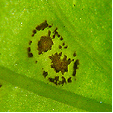 Pustules
Pustules
Symptoms
The upper leaf surface develops red, brown or yellow areas and the underside produces bright yellow to orange spores that correspond to the patches above. Infested leaves become brown in patches, fall prematurely and flower and fruit may also be infected. This overall, results in a loss of vigour and in small plants may lead to death.
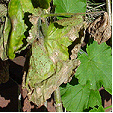 Pelargonium x hortorum
Pelargonium x hortorum
Myrtle Rust (Puccinia psidii) This fungal disease infects plants in the Myrtaceae family and was only recently detected in 2010 and has since spread across eastern Australia from the Northern Territory to Queensland, NSW, Victoria and Tasmania. This rust attacks soft and actively growing foliage or shoots with varying symptoms. It normally starts as small purple spots on the leaves from which spores form in yellow pustules that fade to grey as the infection matures and can merge creating leaf distortion and death of the plant.
The life cycle starts when the powdery yellow spores are distributed by wind to other plants where they germinate and start to grow by piercing the plant cells to obtain nutrients. Germination occurs in dark moist positions with a temperature between 15° to 25°C and the new pustules can release spores in 10 to 12 days, (spores remain viable for 3-months). The spores spread rapidly by wind, water, insects or animals. They are also distributed by plant material, clothing, shoes and vehicles.
 Puccinia psidii
Puccinia psidii
Needle Rust (Melampsora farlowii) infects the new leaves turning them to yellow and fall from the shoot giving the branch a scorched appearance. The fruiting bodies are found on the underside of the leaf and is waxy-red.
Rust in Poplar (Melampsora species). A fungal problem involving at least two species (Melampsora medusae) and (Melampsora larici-idaei).
The upper leaf surface becomes flecked with yellow to light green and the underside produces bright yellow orange spores that correspond to the patches above. Infested leaves become brown in patches, fall prematurely and shoots may die back as a result of not being hardened off to the elements. This overall, results in a loss of vigour and in small plants may lead to death.
The source of the fungus is from other infected plants or fallen leaves and is dispersed by wind.
Host plants include Lombardy Poplars particularly Populus nigra 'Italica' and cottonwoods.
White Rust (Albugo candida) forms snow white pustules that contain colourless spores that turn yellow then brown and are found on the underside of leaves.
White Pine Blister Rust (WPBR) is caused by the fungus (Cronartium ribicola). It is a obligate parasite requiring a living host to survive. The life cycle requires two host species with part of it life on the Pinus species and the other part on Ribes species. First cankers or sores appear on the Pinus species realising spores that land on the Ribes species infecting it. The infection produces a different type of spore that land on the needles and growing branches of the Pinus species and eventually forming cankers. The spores are spread by wind and prefer cool moist conditions. Symptoms include brown spots on the needles and the appearance of dead branches in the crown. Cankers will also appear on the trunk and it tends to attack young trees. Control methods include removal of Ribus species in the affected areas and breading naturally resistant Pinus species.
The Rust (Endophyllum sempervivi) affects Sempervivum species by infecting the young leaves and eventually the crown. The mycelium then travels to the roots and extends into any off shots. Leaves that are infected turn yellowish, grow longer and are thin. Persistent infection may kill the plant.
Source and Dispersal
The source of the fungus is from other infected plants or fallen leaves that contain the fruiting bodies and is dispersed by wind.
Favoured Conditions
Generally rust is more prevalent during summer, preferring warm humid conditions and particularly when the leaves are damp.
Affected Plants
A wide range of ornamental annuals, perennials, ferns, trees, shrubs including, Hibiscus species that are infected by Kuehneola malvicola predominantly in southern USA.
Abies species are infected by many types of rust including (Milesia fructuosa) and (Uredinopsis mirabilis).
Abutilon, Phymosia and Alcea species are infected by the rust (Puccinia heterospora).
Alnus species are occasionally infected with Leaf Rust (Melampsoridium hiratsukanum) which forms yellowish pustules on the leaves that develop turning the leaf brown.
Amelanchler species and Calocedrus decurrens are infected by several rust species including (Gymnosporangium libocedri).
Antirrhinum majus (Snapdragon) is infected by the rust (Puccinia antirrhini). This fungal problem that infects the epidermal layer on the leaf underside, forming pale green areas that are raised and split open revealing reddish brown spores that have a dusty appearance.
As the infestation grows, concentric rings of spore pustules appear around the original infection. The corresponding position on the upper leafs surface turns yellow eventually causing the leaf to wilt and die. The infestation is not restricted to the leaves; all above ground parts of the plant are susceptible and infected plants transmit the fungus dispersing it by wind.
Infected plants should be removed and destroyed.
Anemone and Prunus species are infected by the rust (Tranzschelia pruni-spinosae) that stimulates abnormal growth in the plant during spring.
Aquilegia, Anemone, Delphinium and Clematis species are infected by the Rust (Puccinia rubigo-vera var. agropyri).
Arctostaphylos manzanita is infected by the rust (Pucciniastrum sparsum) occurring in coastal regions but is not normally detrimental to the plant.
Artemisia species are infected by the rust (Uromyces ari-triphylli) which is a systemic disease that is transmitted through seeds. It causes the leaves to turn yellow then die and can infect all parts of the plant except the roots.
Bambusa species are infected by the rust (Dasturella divina) which forms elongated brownish strips on the leaves.
Berberis species may be infected by the Rust (Puccinia graminis) that forms orange spotting on the leaves. It certain regions plants infected with this rust must be removed and destroyed to avoid infecting neighbouring agriculture crops.
Betula species may be infected by Leaf Rust (Melampsoridium betulinum) that forms reddish-yellow spots on the leaves and heavy infestation can defoliate the tree. The host tree changes to Pseudolarix species during the sexual stage and causes blistering of the leaves.
Calendula species may be infected by the Rust (Puccinia flaveriae).
Callistephus and Solidago species may be infected by the Rust (Coleosporium solidaginis) which forms bright yellow spots particularly on new foliage or young plants.
Canna species may be infected by the rust (Puccinia Thaliae).
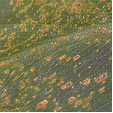
 Canna indica
Canna indica
Centaurea species are infected by the rust (Puccinia cyani) and (Puccinia irrequisita) which can cover the stems and leaves.
Cleome species are infected by the rust (Puccinia aristidae) but rarely requires control.
Dianthus species are infected by the rust (Uromyces dianthi) which forms powdery brown spots that appear on both sides of the leaves. The leaves curl and die and the plant becomes stunted. This is a common problem that occurs when grown in a protected enclosure (hot house).
Ficus species are infected by the rust (Cerotelium fici) which forms small brown spots, and causes the leaves to turn yellow then fall prematurely.
Fuchsia species are infected with (Pucciniastrum epilobii). This fungus caused purplish red blotches on the upper leaf surface, that become dry in the middle and result in a brown patch with purple edges. On the underside of the leaf, corresponding to the patches, yellow orange spores form. Heavily infected leaves become yellow and drop prematurely. This leads to a loss of vigour in the plant and infected plants transmit the fungus.
Certain cultivars are more susceptible than others, particularly 'Orange Drops' and 'Novella'.
Hydrangea species is infected by (Pucciniastrum hydrangeae) causing yellowish brown pustules to appear on both sides of the leaf. The leaf becomes dry and brittle.
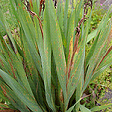
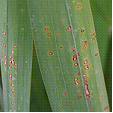 Iris species
Iris species
Iris and Dietes species are very susceptible to the rust (Puccinia iridis). Leaves form rusty red powdery spots that enlarge. They are appear on both sides of the leaves causing the surrounding area to turn pale yellow then brown and the black spores appear soon after, overwintering on dead infected leaves. Plants may be heavily infected but normally survive attack.
Larix species are infected by several Needle Rusts including (Melampsora paradoxa), (Melampsora medusae) and (Melampsoridium betulinum). The fungi attacks the needles predominantly towards the branch tips turning them yellow and eventually killing them . The underside of the leaf develops pale yellow fruiting bodies.
Lupinus species are infected by three species of rust including (Puccinia andropogonis var onobrychidis).
Malus andChaenomeles species may be infected by the rust (Gymnosporangium juniperi-virginianae) or (Gymnosporangium clavipes) which forms brown or bright orange spots on the leaves or twigs and can defoliate the tree. Juniperus virginiana and Mespilus germanica may also be infected by rust.
Mathiola and Arabis species are infected by White Rust.
Pinus species are infects by the Comandra Blister-rust (Cronartium comandre).
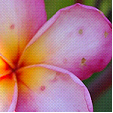
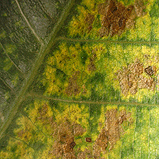
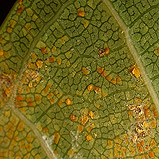
Plumeria rubra Leaf upper surface Leaf underside
Plumeria species are susceptible to the rust (Coleosporium plumeriae). Leaves and flowers may be infected with the underside forming bright yellow pustules and causes premature leaf or flower drop.
Populus nigra 'Italica' is infected by the rust (Melampsora species) which forms pustules to form on the leaves turning them brown and causing premature leaf drop.
Rhododendron and Tsuga species are infected by the rust (Pucciniastrum vaccinii) and is commonly found in nursery stock, spreading rapidly. Tsuga species are also infected by Needle Rust.
Ribes species are infected by the rust (Cronartium ribicola). This leaf rust appears on the underside of the leaves (preferably older leaves) forming dusty brown pustules and is a serious problem. This rust only appears when White Pine (Pinus strobes) grows near where the alternate stage of the fungus occurs.
Rudbeckia species are infected by several species of rust including (Puccinia dioicae) and (Uromyces rudbeckiae).
Salix species are infected by four types of (Melampsora species).
Senecio, Bellis and Calendula species are infected by the rust (Puccinia lagenophora) which forms blister-like pustules that release brown spores.
Sorbus aucuparia is affected by several rust from the (Gymnosporangium species) causing circular yellow spots, that appear on the leaves during summer and develop into orange cup-shaped fruiting bodies.
Trillium species are infected by the rust (Uromyces halstedii) that damages the leaf surface.
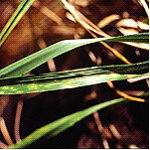 Festuca arundinacea
Festuca arundinacea 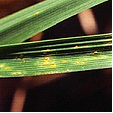 Rust
Rust
Turf Grass are susceptible to rust (Puccinia species) and (Uromyces species), causing yellow flecks to appear on the stems and leaves. These markings enlarge before the pustules form and in severs cases the lawn has a yellow, red or brown appearance.
The infection appears from spring to summer under humid low light conditions and turf that is under stress or with excessive nitrogen in the soil is more susceptible. Many species may be infected including Lolium perenne (Perennial Ryegrass) and Poa pratensis (Kentucky Bluegrass).

 Rust on Perennial Ryegrass
Rust on Perennial Ryegrass
Viburnum species are mildly affected by two types of rust (Coleosporium viburni) and (Puccinia linkii).
Viola species are infected by the rust (Puccinia violae) which forms green spots on the underside of the leaves. It is not commonly seen on cultivated plants.
Non-chemical Control
Cut off and destroy any infected branches, fallen leaves and remove heavily infected plants. Improve the culture by, pruning to improve air circulation, allow space between plants and avoid over crowding. Avoid planting susceptible species. Plants that are infected with a systemic form should be removed and destroyed
Chemical Control
Not possible to spray large trees but young plants may be treated with a protectant fungicide such as wettable sulphur. In a domestic garden small plants such as Fuchsia species may be sprayed with a protectant chemicals as symptoms appear, aided by the removal of existing infected leaves. Under commercial conditions stock may be sprayed with a fungicide such as oxycarboxin.
Note
Always read the label for registration details and direction of use prior to application of any chemicals.
DISEASE
NAME
Brown Rot, Stone Fruit
Sclerotinia fructicola & Sclerotinia laxa
Description
Pathogenic, Fungal Problem
Symptoms
This fast spreading fungal disease attacks flower, fruit and twigs. Infected blossoms turn brown, die and persist on the plant particularly under humid condition. Normally mature fruit is affected forming brown soft patches that rapidly engulf the host that is covered in purplish dusty spores. The fruit becomes completely rotten within 3 top 5 days then shrivels and falls or persists on the plant (mummies). The fungus migrates from the infected fruit and girdles the twigs causing them to die.


Source and Dispersal
The fungus overwinters on dead fruit (mummies) and there stalks or the infested twigs and is spread by wind or water and insects. It can also be spread by moving infected plants or parts of to other areas.
 Mummy
Mummy 
Favoured Conditions
It prefers conditions when the blossoms remain wet for up to 15 hours as in cool nights during rainy periods in spring. It commonly first selects damaged areas for infection.
Affected Plants
Stonefruits are the main host and all species and cultivars are affected.
Non-chemical Control
Avoid watering directly on the blossoms and prune to encourage adequate air circulation. Prune affected twigs and remove dead fruit during winter and destroy. During the growing period remove any infected fruit or flowers immediately and when handling mature fruit avoid damaging the skin.
Chemical Control
Preventative fungicides such as copper oxychloride may be sprayed during the flowering period, prior to rain.
Note
Always read the label for registration details and direction of use prior to application of any chemicals.
DISEASE
NAME
Shot Hole in Stonefruit
Stimina carpophila
Description
A fungal problem

Symptoms
The leaves, fruit and twigs are attacked. The leaves develop small brown spots that have reddish margins. These increase in size up to 6mm across becoming dry then fall out creating the 'shot hole ' appearance and when grouped together form irregular shapes. Twigs exhibit raised brown spots and young shoots form cankers that exude gum. Recurring attack of the twigs can result in dieback, weakening the vigour of the tree. The fruit reveals various symptoms with apricots and almonds forming raised brown scabs and peaches and nectarines having large brown depressed spots that split open and exude gum.
Source and Dispersal
The fungus is derived from infected plant material, particularly the twigs and the spores are dispersed by wind or splashing water.
Favoured Conditions
It is most active in spring during wet weather preferring humid conditions.
Affected Plants
This fungus attacks Stonefruit.
Morinda citrifolia is affected by the fungus (Guignardia morindae) which attacks the leaves.
 Morinda citrifolia
Morinda citrifolia
Non-chemical Control
Remove any infected fruit or twigs or fallen leaves and destroy.
Chemical Control
Plants and fallen leaves can be sprayed with a fungicide (copper oxychloride) during late autumn with a follow up spray in spring.
Note
Always read the label for registration details and direction of use prior to application of any chemicals.
DISEASE
NAME
Root Knot & Other Nematodes
Meloidogyne & other species
Description
Root Knot Nematode or eelworms are transparent thin nematodes that are an organism up to 0.5mm long and attacks the roots by injecting saliva that stimulates the surrounding cells to form galls. The adult male lives in the soil and the female are found in the roots, laying up to 2,000 eggs in a mass in the soil adjoining the roots.
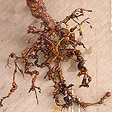
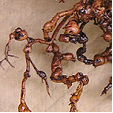
Symptoms
Above ground the plant infected by Root Knot Nematode develops slowly and is stunted. During hot weather the plant wilts easily as it is unable to keep up with the transpiration rate and under extreme conditions the plant dies. The young nematodes attack the roots forcing there way up the root tips forming galls. On inspection the galls are found centrally located along the roots and are up to 20mm across. The galls slow the rate of nutrients and water passing through the plant and as the galls break down they allow opportunity for other diseases to enter the plant.
The roots are severely damaged if the galls are physically removed.
Other species of nematode have simular symptoms and are individually discussed below.
Source and Dispersal
The nematodes are found in soil or in infested plants and are dispersed by water, soil movement and attached to tools or shoes.
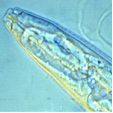 Nema Head
Nema Head
Favoured Conditions
It prefers sandy soil types and a warm moist weather conditions.
Life Cycle
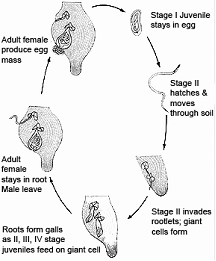
Affected Plants
A wide range of plants are attacked by the Root Knot Nematode including tomatoes, potatoes, carrots, tobacco, hibiscus, gardenia and roses. Some species of nematodes are plant specific such as (Meliodogyne incognita) which attacks Hemerocallis, Celosia and Viola species, forming small wart-like swelling on the roots.
Alternanthera, Begonia, Dianthus, Psidium, Thunbergia and Weigela species are attacked by the Root Nematode (Meloidogyne incognita). This forms small swellings on the roots causing the top growth to be stunted and not responding to improved culture. In cool climates it is found on plants in glasshouses.
Buxus species are attacked by the Meadow Nematode (Pratylenchus species) that turn the leaves a bronze colour and cause stunting of the plant. These microscopic nematodes enters through the roots and eventually result in the death of the plant.
Lagunaria patersonii is attacked by a simular nematode, the Root Burrowing Nematode (Radopholus similis) that feeds by burrowing in the outer root tissue.
Lavandula species that are grown in the northern United States are susceptible to the Peanut Root Knot Nematode (Melioidogyne hapla). Berberis species are also susceptible.
Tulipa species are attacked by Bulb and Stem Nematode (Ditylenchus dipsaci) which forms brownish streaks along the stem that may blister and may cause wilting. The flowers petals become distorted and the general vigour of the plant poor.
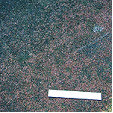
 Nematodes damage
Nematodes damage
Turf Grass are susceptible to several Parasitic Nematodes including (Helicotylenchus species), (Xiphenema Species), (Hemicycliophora species) and (Ibipora lolii). All turf grasses are susceptible and the nematodes are active from spring to autumn requiring a soil temperature 15 ºc. The leaves become chlorotic and have a weak appearance as a result of the damaged roots. Generally it is only a major problem when the nematode numbers are very high, otherwise control is not warranted.
Cultural Control
Crop rotation in infected soils, avoid using plants from the Brassicaceae family for up to four years and plant species that are tolerant of nematodes, this will reduce numbers. Beds may be laid fallow for several seasons to deter nematodes, but numbers build up quickly once susceptible plants return.
Affected plants such as roses may have the bare roots dipped in hot water 45ºC for 15 minutes during the dormant period and contaminated growing media can be heat treated at 60ºC for 30 minutes before being used.
Any infested plants should be removed and destroyed or deposed off site.
Improve the soil structure and avoid acidity by the addition of lime or dolomite. Garden beds may also be pre planted with marigolds or mustard to deter nematodes, but should be removed or thoroughly composted prior to planting as they can push nematodes towards the crop. Green manure crops may be grown prior to planting and infested soil may require up to three seasons of manure crops to bring nematodes under control.
Biological Control
The encouragement of earthworms reduces nematode numbers as they accidentally eat them in there normal course of growth.
Chemical Control
The soil can be treated with a nematicide such as fenamiphos in a domestic situation. Commercial growers may fumigate the soil prior to planting with the appropriate chemicals.
Note
Always read the label for registration details and direction of use prior to application of any chemicals.
Average Lowest Temperature : -10º C 14º F
USDA : 5, 6, 7, 8, 9
This USDA (United States Department of Agriculture) hardiness zone chart can be used to indicate a plant’s ability to withstand average minimum temperatures. However, other factors such as soil type, pH, and moisture, drainage, humidity and exposure to sun and wind will also have a direct effect on your plant’s survival. Use this chart only as a guide, always keep the other factors in mind when deciding where, when and what to plant.
A plant's individual USDA zone can be found in the Plant Overview.
Climate Description
Cool to Cold
These zones have low winter temperatures with moderate humidity and moderate summer temperatures.
Frosts and snow are severe. Droughts rarely occur and wind is cold.
Plant growth
Endemic native and exotic cool climate plants grow well within these zones.
| Dictionary | Growth Habit |
| Leaf Type | Botanic Flower Description |
| Leaf Shape | Flower Inflorescence |
| Leaf Arrangement | Fruit Type |
| Leaf Margin | Bark Type |
| Leaf Apex And Bases | Flower Description |